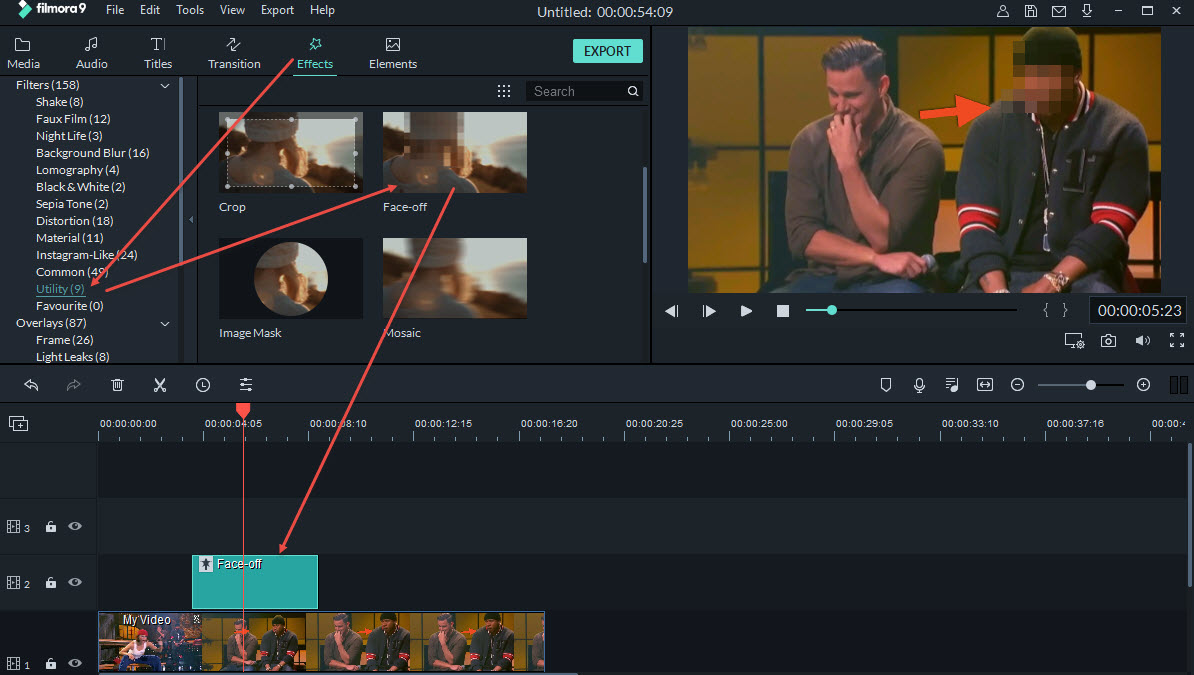:max_bytes(150000):strip_icc():format(webp)/african-american-woman-opening-packages-of-shoes-on-sofa-580503483-5a735094d8fdd50036b63f8a.jpg)
Updated 2024 Approved The VHS Effect in FCP A Beginners Guide to Retro Editing

The VHS Effect in FCP: A Beginner’s Guide to Retro Editing
Do VHS Effect with Final Cut Pro in the Right Way

Shanoon Cox
Mar 27, 2024• Proven solutions
These days, nostalgia for the 1990s appears to be in fashion. VHS effects are among the most popular, as seen in internet photos and mobile apps. If you know how to make VHS effects, you can join the trend by making vintage-style videos.
Fortunately, you don’t have to reshoot your video using an analog camera and transfer the movie to a VCR video format to achieve the effect of an old recording (with the date on the screen, tracking lines, and other telltale indications). It’s made up of a few similar layers with slightly different Effects and a fun overlay layer to give it that tubular, radical ‘90s vibe.
In this article, you will learn how to add VHS effects to a video in Final Cut Pro X, how to use VHS video effects, and some common VHS filter choices to use in your next project, so keep reading:
Part1: How to do VHS effect in FCPX?
A VHS effect is a textured, warped effect that looks like an outdated analog videotape cassette recording. Adding this antique effect to an edit adds a fantastic old-school discord. How often should you utilize these glitchy and vintage effects? When the mood you’re trying to create begs for some visual or aural distortion. Perhaps you need to recreate the appearance of discovered film or express a dramatic flashback to a character’s history. In any case, VHS tapes and glitch effects are pretty trendy right now.

If you want to know how to add VHS effect to your videos without any plugins in Final Cut Pro X, then follow these steps:
Open Final Cut Pro and click on New Project.
Name your project as VHS effect in the Project Name section. Change the Video format to NTSC SD and frame rate to 29.97p. Click on Ok.

Drag and drop your footage in the timeline of FCPX. After this, scale your project so that it fits the frame.
Open the Effects, and in the search bar, type Add Noise. Select the Add Noise effect and drop it on your footage.

Go to the option Blend Mode and select Color Dodge. Now click on Type and select Gaussian Noise (Film Grain). In the Amount section, add the amount between 0.23-0.32.
Now go back to the search bar and type Gaussian Blur. Select that and drop it to your footage in FCPX.

Go to the Gaussian settings and set the amount to roughly 2.0-3.0.
Go back to the search bar in FCPX and type Sharpen. Select the Sharpen effect and drop it to your footage in Final Cut Pro.

Set the amount of sharpness to around 8.0-9.0.
Now in the search bar type Bad TV effect. Select it and drop it on your footage in FCPX.

Set the amount of the effect to roughly around 8.0-9.0. In the option, Static Type, select Gaussian Noise (Film Grain). Select Soft Light in Static Blend mode option.
Now go to the search bar again and type Prism. Select the prism effect and drop it to your footage in Final Cut Pro. This will add some 3D effect to your footage.

Set the amount to around 13.0-14.0.
Go back to the search bar and type Color Correction. Drag and drop this effect to your footage in Final Cut Pro.

Click on Exposure and adjust the Highlights, Midtones, and Shadow. Go to the Saturation option and lower it. Now go to the Color and adjust the tint of your video by changing the Global option. Also, adjust the Highlights, Midtones, and Shadows. Wait for a few minutes for it to render.
After your video is rendered, you will get the final results using the VHS filter in Final Cut Pro. Your video will look like it was made in a VCR Video format.

Part2: How to do VHS effect in easy steps?
If you want to quickly add VHS effect to your video, you can use Filmora X. You will have to add different effects and values to get the final results. You can use VHS effects on your lyric video, intro, outro, or any other video that you like by following the same process.
First, if you haven’t got Filmora, click here to download it for free!
To do VHS effects quickly, follow these steps:

- Open Wondershare Filmora on your device.
- Go to the Media tab and select Sample Colors.
- Select the Black Color.
- Drag and drop it to your project timeline and adjust its duration.
- Click on the Titles tab and select the End Credits.
- Drag and drop Credit 1 to your project timeline and pace it above the black image.
- Stretch it all the way to the black image. Change all the text in it as you like.

Go to Effect, and in the search bar, type VHS.
- Drag and drop the VHS Distortion Bad effect on the timeline above the text layer.
- Double click on it and change the Alpha value to 25 and click Ok.

- Now drag the VHS Distortion effect and place it above the previous one.
- Double click on it and change its Alpha value to 35 and click Ok.

- Drag and Place the VHS Rewind effect above the previous layer.
- Change its Alpha value to 10 and click Ok.

Now search for the Strong Glitch effect.
- Drag and drop it above the previous layer.
- Stretch it all the way across.
- Change its Alpha value to 25 and click Ok.

Search for Chromatic Aberration effect.
- Drag and drop it above the previous layer.
- Stretch it all the way across.
- Double click on it.
- Change its Alpha value to 60 and Fade to 0.05 and click Ok.

Now Search for VCR Distortion in the search bar.
- Drag and drop it above the previous layer.
- Stretch it all the way across. Double click on it.
- Change its Alpha value to 25 and click Ok.
- Add Glitch Distortion effect above the previous one.
- Drag and drop it above the last layer.
- Stretch it all the way across.
- Change its Alpha value to 30 and click Ok.
- At last, add the Distort effect and place it above the top of all layers.
- Change its Amplitude value to 15, Frequency value to 17, and Alpha value to 0 and click Ok.
- Export your video.
You can play around with these values to change the intensity of the VHS effect.
Still not enough? See this article: The Best Glitch Video Editors.
Part3: Where to find the best plugins or templates for the VHS effect?
If you want to recreate some of that analog feel to your video clip with plugins or templates, you can use the following recommendations to give your film a VHS effect:
Damaged VHS Effects
This is a paid collection; however, it has an extensive library of VHS-style effects. The variety of effects is impressive, with some slight distortions and others that are almost unwatchable. There’s also some stock video from TV, sound effects, and transitions. Everything may be customized to your taste.
This template will set you back $59, which is a small price to pay for such a large selection. Only After Effects CS3 and above are supported!
VHS Opener
This After Effects template is jam-packed with effects and glitches that are ideal for conjuring a nostalgic mood. Upload your film and customize your titles and text. This is a simple, vintage template that you may use.
A resources center built for Filmora. You can find all the materials and effects you need in Filmstock, including VHS effect.
Click to learn more about glitch effect in Filmstock.

Stories – Glitch & VHS Edition
This template is ideal for use with mobile apps like Instagram Stories. You’ll get two vertical video openers, complete with glitches and VHS effects. Premiere Pro CC 2017 and newer are supported!
VHS Glitch
The look of a VHS glitch effect is basic yet incredibly authentic. This one was made in an old-school way by causing damage to the inside of a genuine VHS tape and capturing the effect. It can’t get much more natural than that! To be confident of what you can and can’t do with this overlay, read the license information
Conclusion
The appearance and feel of your production may be significantly enhanced by using VHS video effects. Nothing brings back memories for a viewer like a VHS video. By following the steps mentioned above, you can easily use the VHS effect in your video. However, we recommend you use Wondershare Filmore to create VHS effect as you wouldn’t require any plugin. What are some of your favorite VHS effects?

Shanoon Cox
Shanoon Cox is a writer and a lover of all things video.
Follow @Shanoon Cox
Shanoon Cox
Mar 27, 2024• Proven solutions
These days, nostalgia for the 1990s appears to be in fashion. VHS effects are among the most popular, as seen in internet photos and mobile apps. If you know how to make VHS effects, you can join the trend by making vintage-style videos.
Fortunately, you don’t have to reshoot your video using an analog camera and transfer the movie to a VCR video format to achieve the effect of an old recording (with the date on the screen, tracking lines, and other telltale indications). It’s made up of a few similar layers with slightly different Effects and a fun overlay layer to give it that tubular, radical ‘90s vibe.
In this article, you will learn how to add VHS effects to a video in Final Cut Pro X, how to use VHS video effects, and some common VHS filter choices to use in your next project, so keep reading:
Part1: How to do VHS effect in FCPX?
A VHS effect is a textured, warped effect that looks like an outdated analog videotape cassette recording. Adding this antique effect to an edit adds a fantastic old-school discord. How often should you utilize these glitchy and vintage effects? When the mood you’re trying to create begs for some visual or aural distortion. Perhaps you need to recreate the appearance of discovered film or express a dramatic flashback to a character’s history. In any case, VHS tapes and glitch effects are pretty trendy right now.

If you want to know how to add VHS effect to your videos without any plugins in Final Cut Pro X, then follow these steps:
Open Final Cut Pro and click on New Project.
Name your project as VHS effect in the Project Name section. Change the Video format to NTSC SD and frame rate to 29.97p. Click on Ok.

Drag and drop your footage in the timeline of FCPX. After this, scale your project so that it fits the frame.
Open the Effects, and in the search bar, type Add Noise. Select the Add Noise effect and drop it on your footage.

Go to the option Blend Mode and select Color Dodge. Now click on Type and select Gaussian Noise (Film Grain). In the Amount section, add the amount between 0.23-0.32.
Now go back to the search bar and type Gaussian Blur. Select that and drop it to your footage in FCPX.

Go to the Gaussian settings and set the amount to roughly 2.0-3.0.
Go back to the search bar in FCPX and type Sharpen. Select the Sharpen effect and drop it to your footage in Final Cut Pro.

Set the amount of sharpness to around 8.0-9.0.
Now in the search bar type Bad TV effect. Select it and drop it on your footage in FCPX.

Set the amount of the effect to roughly around 8.0-9.0. In the option, Static Type, select Gaussian Noise (Film Grain). Select Soft Light in Static Blend mode option.
Now go to the search bar again and type Prism. Select the prism effect and drop it to your footage in Final Cut Pro. This will add some 3D effect to your footage.

Set the amount to around 13.0-14.0.
Go back to the search bar and type Color Correction. Drag and drop this effect to your footage in Final Cut Pro.

Click on Exposure and adjust the Highlights, Midtones, and Shadow. Go to the Saturation option and lower it. Now go to the Color and adjust the tint of your video by changing the Global option. Also, adjust the Highlights, Midtones, and Shadows. Wait for a few minutes for it to render.
After your video is rendered, you will get the final results using the VHS filter in Final Cut Pro. Your video will look like it was made in a VCR Video format.

Part2: How to do VHS effect in easy steps?
If you want to quickly add VHS effect to your video, you can use Filmora X. You will have to add different effects and values to get the final results. You can use VHS effects on your lyric video, intro, outro, or any other video that you like by following the same process.
First, if you haven’t got Filmora, click here to download it for free!
To do VHS effects quickly, follow these steps:

- Open Wondershare Filmora on your device.
- Go to the Media tab and select Sample Colors.
- Select the Black Color.
- Drag and drop it to your project timeline and adjust its duration.
- Click on the Titles tab and select the End Credits.
- Drag and drop Credit 1 to your project timeline and pace it above the black image.
- Stretch it all the way to the black image. Change all the text in it as you like.

Go to Effect, and in the search bar, type VHS.
- Drag and drop the VHS Distortion Bad effect on the timeline above the text layer.
- Double click on it and change the Alpha value to 25 and click Ok.

- Now drag the VHS Distortion effect and place it above the previous one.
- Double click on it and change its Alpha value to 35 and click Ok.

- Drag and Place the VHS Rewind effect above the previous layer.
- Change its Alpha value to 10 and click Ok.

Now search for the Strong Glitch effect.
- Drag and drop it above the previous layer.
- Stretch it all the way across.
- Change its Alpha value to 25 and click Ok.

Search for Chromatic Aberration effect.
- Drag and drop it above the previous layer.
- Stretch it all the way across.
- Double click on it.
- Change its Alpha value to 60 and Fade to 0.05 and click Ok.

Now Search for VCR Distortion in the search bar.
- Drag and drop it above the previous layer.
- Stretch it all the way across. Double click on it.
- Change its Alpha value to 25 and click Ok.
- Add Glitch Distortion effect above the previous one.
- Drag and drop it above the last layer.
- Stretch it all the way across.
- Change its Alpha value to 30 and click Ok.
- At last, add the Distort effect and place it above the top of all layers.
- Change its Amplitude value to 15, Frequency value to 17, and Alpha value to 0 and click Ok.
- Export your video.
You can play around with these values to change the intensity of the VHS effect.
Still not enough? See this article: The Best Glitch Video Editors.
Part3: Where to find the best plugins or templates for the VHS effect?
If you want to recreate some of that analog feel to your video clip with plugins or templates, you can use the following recommendations to give your film a VHS effect:
Damaged VHS Effects
This is a paid collection; however, it has an extensive library of VHS-style effects. The variety of effects is impressive, with some slight distortions and others that are almost unwatchable. There’s also some stock video from TV, sound effects, and transitions. Everything may be customized to your taste.
This template will set you back $59, which is a small price to pay for such a large selection. Only After Effects CS3 and above are supported!
VHS Opener
This After Effects template is jam-packed with effects and glitches that are ideal for conjuring a nostalgic mood. Upload your film and customize your titles and text. This is a simple, vintage template that you may use.
A resources center built for Filmora. You can find all the materials and effects you need in Filmstock, including VHS effect.
Click to learn more about glitch effect in Filmstock.

Stories – Glitch & VHS Edition
This template is ideal for use with mobile apps like Instagram Stories. You’ll get two vertical video openers, complete with glitches and VHS effects. Premiere Pro CC 2017 and newer are supported!
VHS Glitch
The look of a VHS glitch effect is basic yet incredibly authentic. This one was made in an old-school way by causing damage to the inside of a genuine VHS tape and capturing the effect. It can’t get much more natural than that! To be confident of what you can and can’t do with this overlay, read the license information
Conclusion
The appearance and feel of your production may be significantly enhanced by using VHS video effects. Nothing brings back memories for a viewer like a VHS video. By following the steps mentioned above, you can easily use the VHS effect in your video. However, we recommend you use Wondershare Filmore to create VHS effect as you wouldn’t require any plugin. What are some of your favorite VHS effects?

Shanoon Cox
Shanoon Cox is a writer and a lover of all things video.
Follow @Shanoon Cox
Shanoon Cox
Mar 27, 2024• Proven solutions
These days, nostalgia for the 1990s appears to be in fashion. VHS effects are among the most popular, as seen in internet photos and mobile apps. If you know how to make VHS effects, you can join the trend by making vintage-style videos.
Fortunately, you don’t have to reshoot your video using an analog camera and transfer the movie to a VCR video format to achieve the effect of an old recording (with the date on the screen, tracking lines, and other telltale indications). It’s made up of a few similar layers with slightly different Effects and a fun overlay layer to give it that tubular, radical ‘90s vibe.
In this article, you will learn how to add VHS effects to a video in Final Cut Pro X, how to use VHS video effects, and some common VHS filter choices to use in your next project, so keep reading:
Part1: How to do VHS effect in FCPX?
A VHS effect is a textured, warped effect that looks like an outdated analog videotape cassette recording. Adding this antique effect to an edit adds a fantastic old-school discord. How often should you utilize these glitchy and vintage effects? When the mood you’re trying to create begs for some visual or aural distortion. Perhaps you need to recreate the appearance of discovered film or express a dramatic flashback to a character’s history. In any case, VHS tapes and glitch effects are pretty trendy right now.

If you want to know how to add VHS effect to your videos without any plugins in Final Cut Pro X, then follow these steps:
Open Final Cut Pro and click on New Project.
Name your project as VHS effect in the Project Name section. Change the Video format to NTSC SD and frame rate to 29.97p. Click on Ok.

Drag and drop your footage in the timeline of FCPX. After this, scale your project so that it fits the frame.
Open the Effects, and in the search bar, type Add Noise. Select the Add Noise effect and drop it on your footage.

Go to the option Blend Mode and select Color Dodge. Now click on Type and select Gaussian Noise (Film Grain). In the Amount section, add the amount between 0.23-0.32.
Now go back to the search bar and type Gaussian Blur. Select that and drop it to your footage in FCPX.

Go to the Gaussian settings and set the amount to roughly 2.0-3.0.
Go back to the search bar in FCPX and type Sharpen. Select the Sharpen effect and drop it to your footage in Final Cut Pro.

Set the amount of sharpness to around 8.0-9.0.
Now in the search bar type Bad TV effect. Select it and drop it on your footage in FCPX.

Set the amount of the effect to roughly around 8.0-9.0. In the option, Static Type, select Gaussian Noise (Film Grain). Select Soft Light in Static Blend mode option.
Now go to the search bar again and type Prism. Select the prism effect and drop it to your footage in Final Cut Pro. This will add some 3D effect to your footage.

Set the amount to around 13.0-14.0.
Go back to the search bar and type Color Correction. Drag and drop this effect to your footage in Final Cut Pro.

Click on Exposure and adjust the Highlights, Midtones, and Shadow. Go to the Saturation option and lower it. Now go to the Color and adjust the tint of your video by changing the Global option. Also, adjust the Highlights, Midtones, and Shadows. Wait for a few minutes for it to render.
After your video is rendered, you will get the final results using the VHS filter in Final Cut Pro. Your video will look like it was made in a VCR Video format.

Part2: How to do VHS effect in easy steps?
If you want to quickly add VHS effect to your video, you can use Filmora X. You will have to add different effects and values to get the final results. You can use VHS effects on your lyric video, intro, outro, or any other video that you like by following the same process.
First, if you haven’t got Filmora, click here to download it for free!
To do VHS effects quickly, follow these steps:

- Open Wondershare Filmora on your device.
- Go to the Media tab and select Sample Colors.
- Select the Black Color.
- Drag and drop it to your project timeline and adjust its duration.
- Click on the Titles tab and select the End Credits.
- Drag and drop Credit 1 to your project timeline and pace it above the black image.
- Stretch it all the way to the black image. Change all the text in it as you like.

Go to Effect, and in the search bar, type VHS.
- Drag and drop the VHS Distortion Bad effect on the timeline above the text layer.
- Double click on it and change the Alpha value to 25 and click Ok.

- Now drag the VHS Distortion effect and place it above the previous one.
- Double click on it and change its Alpha value to 35 and click Ok.

- Drag and Place the VHS Rewind effect above the previous layer.
- Change its Alpha value to 10 and click Ok.

Now search for the Strong Glitch effect.
- Drag and drop it above the previous layer.
- Stretch it all the way across.
- Change its Alpha value to 25 and click Ok.

Search for Chromatic Aberration effect.
- Drag and drop it above the previous layer.
- Stretch it all the way across.
- Double click on it.
- Change its Alpha value to 60 and Fade to 0.05 and click Ok.

Now Search for VCR Distortion in the search bar.
- Drag and drop it above the previous layer.
- Stretch it all the way across. Double click on it.
- Change its Alpha value to 25 and click Ok.
- Add Glitch Distortion effect above the previous one.
- Drag and drop it above the last layer.
- Stretch it all the way across.
- Change its Alpha value to 30 and click Ok.
- At last, add the Distort effect and place it above the top of all layers.
- Change its Amplitude value to 15, Frequency value to 17, and Alpha value to 0 and click Ok.
- Export your video.
You can play around with these values to change the intensity of the VHS effect.
Still not enough? See this article: The Best Glitch Video Editors.
Part3: Where to find the best plugins or templates for the VHS effect?
If you want to recreate some of that analog feel to your video clip with plugins or templates, you can use the following recommendations to give your film a VHS effect:
Damaged VHS Effects
This is a paid collection; however, it has an extensive library of VHS-style effects. The variety of effects is impressive, with some slight distortions and others that are almost unwatchable. There’s also some stock video from TV, sound effects, and transitions. Everything may be customized to your taste.
This template will set you back $59, which is a small price to pay for such a large selection. Only After Effects CS3 and above are supported!
VHS Opener
This After Effects template is jam-packed with effects and glitches that are ideal for conjuring a nostalgic mood. Upload your film and customize your titles and text. This is a simple, vintage template that you may use.
A resources center built for Filmora. You can find all the materials and effects you need in Filmstock, including VHS effect.
Click to learn more about glitch effect in Filmstock.

Stories – Glitch & VHS Edition
This template is ideal for use with mobile apps like Instagram Stories. You’ll get two vertical video openers, complete with glitches and VHS effects. Premiere Pro CC 2017 and newer are supported!
VHS Glitch
The look of a VHS glitch effect is basic yet incredibly authentic. This one was made in an old-school way by causing damage to the inside of a genuine VHS tape and capturing the effect. It can’t get much more natural than that! To be confident of what you can and can’t do with this overlay, read the license information
Conclusion
The appearance and feel of your production may be significantly enhanced by using VHS video effects. Nothing brings back memories for a viewer like a VHS video. By following the steps mentioned above, you can easily use the VHS effect in your video. However, we recommend you use Wondershare Filmore to create VHS effect as you wouldn’t require any plugin. What are some of your favorite VHS effects?

Shanoon Cox
Shanoon Cox is a writer and a lover of all things video.
Follow @Shanoon Cox
Shanoon Cox
Mar 27, 2024• Proven solutions
These days, nostalgia for the 1990s appears to be in fashion. VHS effects are among the most popular, as seen in internet photos and mobile apps. If you know how to make VHS effects, you can join the trend by making vintage-style videos.
Fortunately, you don’t have to reshoot your video using an analog camera and transfer the movie to a VCR video format to achieve the effect of an old recording (with the date on the screen, tracking lines, and other telltale indications). It’s made up of a few similar layers with slightly different Effects and a fun overlay layer to give it that tubular, radical ‘90s vibe.
In this article, you will learn how to add VHS effects to a video in Final Cut Pro X, how to use VHS video effects, and some common VHS filter choices to use in your next project, so keep reading:
Part1: How to do VHS effect in FCPX?
A VHS effect is a textured, warped effect that looks like an outdated analog videotape cassette recording. Adding this antique effect to an edit adds a fantastic old-school discord. How often should you utilize these glitchy and vintage effects? When the mood you’re trying to create begs for some visual or aural distortion. Perhaps you need to recreate the appearance of discovered film or express a dramatic flashback to a character’s history. In any case, VHS tapes and glitch effects are pretty trendy right now.

If you want to know how to add VHS effect to your videos without any plugins in Final Cut Pro X, then follow these steps:
Open Final Cut Pro and click on New Project.
Name your project as VHS effect in the Project Name section. Change the Video format to NTSC SD and frame rate to 29.97p. Click on Ok.

Drag and drop your footage in the timeline of FCPX. After this, scale your project so that it fits the frame.
Open the Effects, and in the search bar, type Add Noise. Select the Add Noise effect and drop it on your footage.

Go to the option Blend Mode and select Color Dodge. Now click on Type and select Gaussian Noise (Film Grain). In the Amount section, add the amount between 0.23-0.32.
Now go back to the search bar and type Gaussian Blur. Select that and drop it to your footage in FCPX.

Go to the Gaussian settings and set the amount to roughly 2.0-3.0.
Go back to the search bar in FCPX and type Sharpen. Select the Sharpen effect and drop it to your footage in Final Cut Pro.

Set the amount of sharpness to around 8.0-9.0.
Now in the search bar type Bad TV effect. Select it and drop it on your footage in FCPX.

Set the amount of the effect to roughly around 8.0-9.0. In the option, Static Type, select Gaussian Noise (Film Grain). Select Soft Light in Static Blend mode option.
Now go to the search bar again and type Prism. Select the prism effect and drop it to your footage in Final Cut Pro. This will add some 3D effect to your footage.

Set the amount to around 13.0-14.0.
Go back to the search bar and type Color Correction. Drag and drop this effect to your footage in Final Cut Pro.

Click on Exposure and adjust the Highlights, Midtones, and Shadow. Go to the Saturation option and lower it. Now go to the Color and adjust the tint of your video by changing the Global option. Also, adjust the Highlights, Midtones, and Shadows. Wait for a few minutes for it to render.
After your video is rendered, you will get the final results using the VHS filter in Final Cut Pro. Your video will look like it was made in a VCR Video format.

Part2: How to do VHS effect in easy steps?
If you want to quickly add VHS effect to your video, you can use Filmora X. You will have to add different effects and values to get the final results. You can use VHS effects on your lyric video, intro, outro, or any other video that you like by following the same process.
First, if you haven’t got Filmora, click here to download it for free!
To do VHS effects quickly, follow these steps:

- Open Wondershare Filmora on your device.
- Go to the Media tab and select Sample Colors.
- Select the Black Color.
- Drag and drop it to your project timeline and adjust its duration.
- Click on the Titles tab and select the End Credits.
- Drag and drop Credit 1 to your project timeline and pace it above the black image.
- Stretch it all the way to the black image. Change all the text in it as you like.

Go to Effect, and in the search bar, type VHS.
- Drag and drop the VHS Distortion Bad effect on the timeline above the text layer.
- Double click on it and change the Alpha value to 25 and click Ok.

- Now drag the VHS Distortion effect and place it above the previous one.
- Double click on it and change its Alpha value to 35 and click Ok.

- Drag and Place the VHS Rewind effect above the previous layer.
- Change its Alpha value to 10 and click Ok.

Now search for the Strong Glitch effect.
- Drag and drop it above the previous layer.
- Stretch it all the way across.
- Change its Alpha value to 25 and click Ok.

Search for Chromatic Aberration effect.
- Drag and drop it above the previous layer.
- Stretch it all the way across.
- Double click on it.
- Change its Alpha value to 60 and Fade to 0.05 and click Ok.

Now Search for VCR Distortion in the search bar.
- Drag and drop it above the previous layer.
- Stretch it all the way across. Double click on it.
- Change its Alpha value to 25 and click Ok.
- Add Glitch Distortion effect above the previous one.
- Drag and drop it above the last layer.
- Stretch it all the way across.
- Change its Alpha value to 30 and click Ok.
- At last, add the Distort effect and place it above the top of all layers.
- Change its Amplitude value to 15, Frequency value to 17, and Alpha value to 0 and click Ok.
- Export your video.
You can play around with these values to change the intensity of the VHS effect.
Still not enough? See this article: The Best Glitch Video Editors.
Part3: Where to find the best plugins or templates for the VHS effect?
If you want to recreate some of that analog feel to your video clip with plugins or templates, you can use the following recommendations to give your film a VHS effect:
Damaged VHS Effects
This is a paid collection; however, it has an extensive library of VHS-style effects. The variety of effects is impressive, with some slight distortions and others that are almost unwatchable. There’s also some stock video from TV, sound effects, and transitions. Everything may be customized to your taste.
This template will set you back $59, which is a small price to pay for such a large selection. Only After Effects CS3 and above are supported!
VHS Opener
This After Effects template is jam-packed with effects and glitches that are ideal for conjuring a nostalgic mood. Upload your film and customize your titles and text. This is a simple, vintage template that you may use.
A resources center built for Filmora. You can find all the materials and effects you need in Filmstock, including VHS effect.
Click to learn more about glitch effect in Filmstock.

Stories – Glitch & VHS Edition
This template is ideal for use with mobile apps like Instagram Stories. You’ll get two vertical video openers, complete with glitches and VHS effects. Premiere Pro CC 2017 and newer are supported!
VHS Glitch
The look of a VHS glitch effect is basic yet incredibly authentic. This one was made in an old-school way by causing damage to the inside of a genuine VHS tape and capturing the effect. It can’t get much more natural than that! To be confident of what you can and can’t do with this overlay, read the license information
Conclusion
The appearance and feel of your production may be significantly enhanced by using VHS video effects. Nothing brings back memories for a viewer like a VHS video. By following the steps mentioned above, you can easily use the VHS effect in your video. However, we recommend you use Wondershare Filmore to create VHS effect as you wouldn’t require any plugin. What are some of your favorite VHS effects?

Shanoon Cox
Shanoon Cox is a writer and a lover of all things video.
Follow @Shanoon Cox
Blurring Faces with Best Video Editing Software
Best Video Editing Software to Blur Faces in Video

Ollie Mattison
Mar 27, 2024• Proven solutions
One of the most commonly sought bits of video-editing knowledge is the ability to blur the face in videos, whether for privacy reasons, artistic effect, or whatever sort of thing you’re going for. You can go wild once you learn how to blur certain parts of a video, and this is something that, in our opinion, every aspiring video editor should learn how to do.
Now there are hundreds of video editing software, and every video editor has his own personal choice when it comes to choosing the right tool for the job. Our list focuses on what are, in our opinion, the most accessible and efficient NLE’s on the market.
1. Blur Face with Filmora Video Editor [with Faceoff / Mosaic]
Filmora is a favorite among many amateur video editors because the free version is robust by itself and features most of what one would need when not dealing with professional projects. It is available for both macOS and Windows.
How to Blur the Faces in Filmora:
- Select the clip that needs to apply blur face in the timeline, and then go to the Effects tab and select Utility.

- If the image is still, then you can click Mosaic option and drag it in the video clip in the timeline.
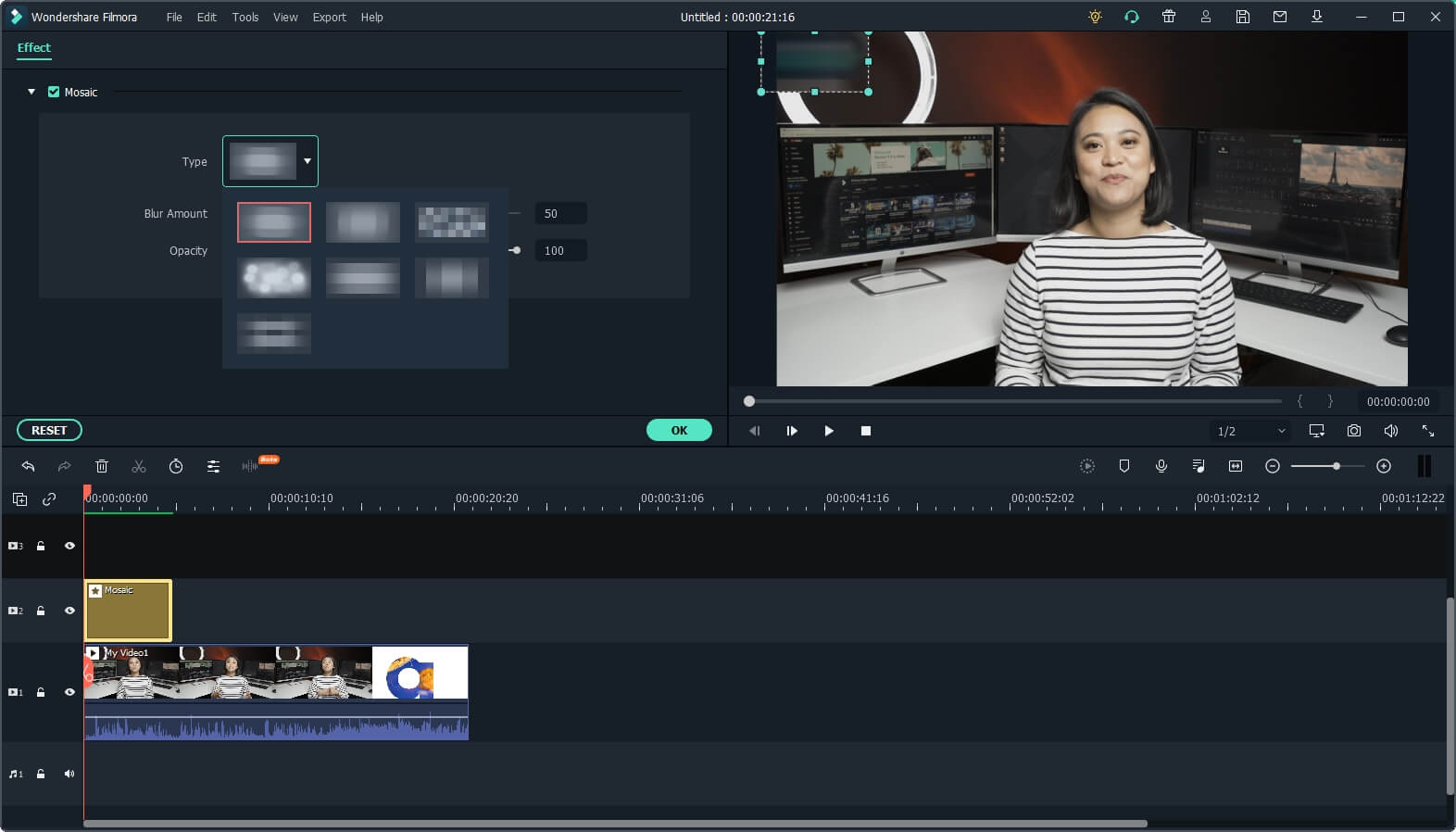
- Double click the video clip applied Mosaic effect in the timeline to enter the video effects tab, in where you can dictate the size of the area, the mosaic types, and also adjust the opacity.
- If the image is in motion and you’d like the blurred area to be mobile as well, drag the Face Off from the Effects tab to the timeline and adjust it in the Video Effects tab as well. You can pick the face-off pattern under Video Effects and the Face-off feature will tracks the face that appears on the screen and applies a blur to it.
- When you’re done, click OK to save the changes and then click Export and pick your desired video format.
Learn more detail about Adding Blur effects to Videos in Filmora .
2. Using YouTube Video Enhancements to Blur Faces
Those interested in learning how to blur faces in videos in order to apply the trick to their You Tube videos will find the fact that you can do this through the Video Enhancements section of your Creator Studios dashboard quite convenient. This addition is something that has been introduced in 2006 and has been well received by the community.
How to Blur the Faces with YouTube Enhancement tool:
- Sign in your YouTube account and select the Creator Studio option after clicking the avatar. Locate the video that you want to edit and access video Enhancements.
- You will see two blurring options in the Enhancement window: Blur faces and Custom blurring. To blur all faces appear in the video, go to Blur faces and click Edit
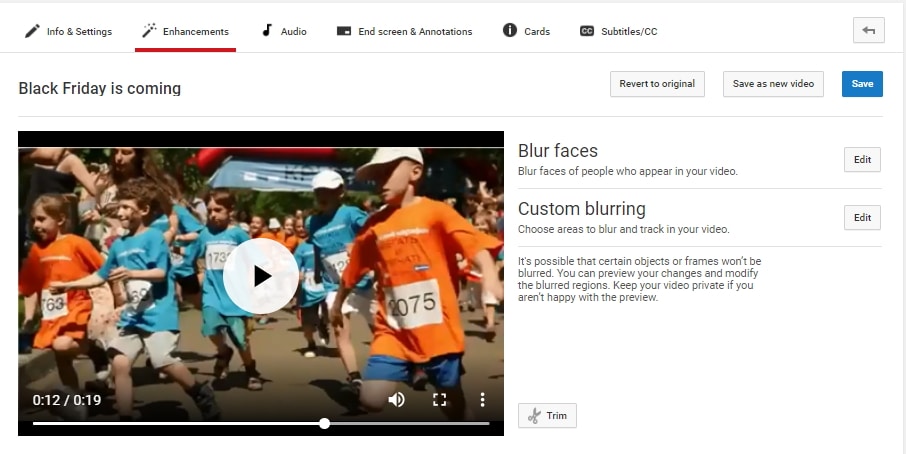
- YouTube will use the face detection tool to analyze all faces in the video and displays the faces in the left side. You can click the face image to blur a specific face throughout the video.
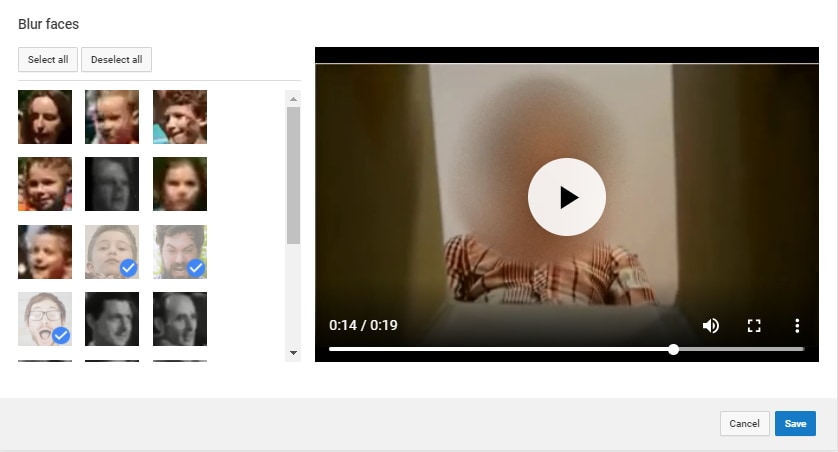
- Preview the blurring effects and if everything goes OK, click Save to save the face blurring effect to video. After you’re finished the editing, click Save to save the edits in-place, or Save as New Video, which creates a new video (this would mean, however, that you would lose any views you previously had).
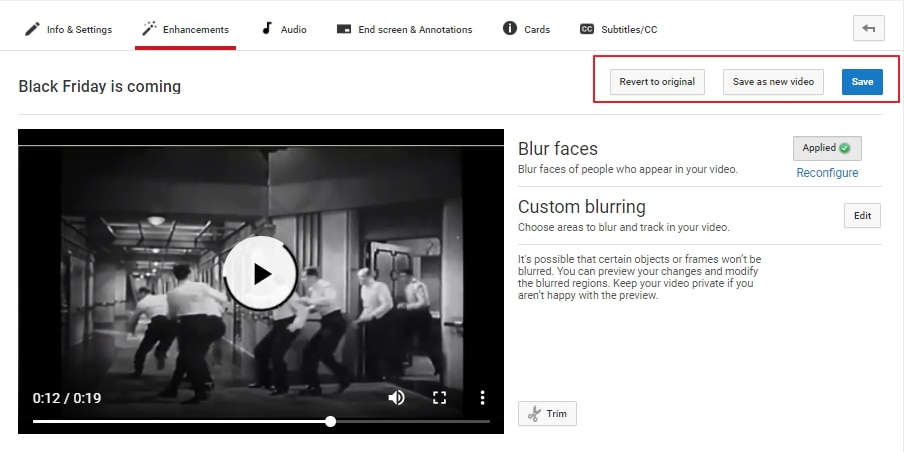
In the Enhancement window, you can also blur a specific area of the video with the custom blurring option. Want to edit YouTube videos with more features, check our picks of thebest video editing software for YouTubers in 2018.
3. Blur Face with Movavi video editor
Movavi is a popular choice for when it comes to free video editing softwares. It is available for both Windows and MacOS and is a breeze to work in - the perfect software to learn how to blur the faces in videos in.
How to Blur the Faces with Movavi video editor:
- Open Movavi and locate the Filters
- Click Blur.

- Once the filter gallery opens, drag your desired filter over the clip or image.
- You can apply either the Blur Intense or the Blur Mild effects if you would like to determine their strength.
- In order to blur a specific part of the video, select the clip and locate the More
- Click Highlight and Conceal, and then click Conceal.
- Position the orange box over the area that you want to be affected.
- You can adjust the Opacity slider to determne the strength of the effect.
- Click on Pixels if you want the blur preset to be pixellated.
- You can also click on Add Mask if you would like to apply a mask to certain areas of the clip.
4. Blur face with Adobe Premiere Pro CC professional video editor
Premiere Pro CC is Adobe’s dedicated video editing software. There are many video editors out there that have some experience in Photoshop as well, and since there’s a chance they work in Premiere Pro CC due to how similar the UI of both of these products is, we’ve decided to give this NLE some attention as well. Available for both MacOS and Windows.
How to Blur the Faces in Premiere Pro?
- Select the video clip in the timeline.
- Access the Effects tab, and then click Video Effects, and then Stylize.
- Click Mosaic.
- Go to the Effects Control tab, and pick the shape of blurred area. The elliptical and 4-point polygon mask options are what most people use when blurring faces in particular.
- Drag the Mask over the intended area
- Adjust Positioning, Scale, and/or Rotation to your liking.
- You can fine-tune the effect further by adjusting the Mask Expansion, the Horizontal and Vertical blocks the mosaic effect is composed of, and the Feather
What sort of video editing software you go for when you want to edit the face in videos is ultimately up to you - we’ve only expressed our personal preferences in the hopes that it might help some of the people that are interested in the subject. Most of the steps present in this list are similar to each other and you will find that once you learn how to do this trick, you will become far more familiarized with all the various effects available to you.

Ollie Mattison
Ollie Mattison is a writer and a lover of all things video.
Follow @Ollie Mattison
Ollie Mattison
Mar 27, 2024• Proven solutions
One of the most commonly sought bits of video-editing knowledge is the ability to blur the face in videos, whether for privacy reasons, artistic effect, or whatever sort of thing you’re going for. You can go wild once you learn how to blur certain parts of a video, and this is something that, in our opinion, every aspiring video editor should learn how to do.
Now there are hundreds of video editing software, and every video editor has his own personal choice when it comes to choosing the right tool for the job. Our list focuses on what are, in our opinion, the most accessible and efficient NLE’s on the market.
1. Blur Face with Filmora Video Editor [with Faceoff / Mosaic]
Filmora is a favorite among many amateur video editors because the free version is robust by itself and features most of what one would need when not dealing with professional projects. It is available for both macOS and Windows.
How to Blur the Faces in Filmora:
- Select the clip that needs to apply blur face in the timeline, and then go to the Effects tab and select Utility.

- If the image is still, then you can click Mosaic option and drag it in the video clip in the timeline.

- Double click the video clip applied Mosaic effect in the timeline to enter the video effects tab, in where you can dictate the size of the area, the mosaic types, and also adjust the opacity.
- If the image is in motion and you’d like the blurred area to be mobile as well, drag the Face Off from the Effects tab to the timeline and adjust it in the Video Effects tab as well. You can pick the face-off pattern under Video Effects and the Face-off feature will tracks the face that appears on the screen and applies a blur to it.
- When you’re done, click OK to save the changes and then click Export and pick your desired video format.
Learn more detail about Adding Blur effects to Videos in Filmora .
2. Using YouTube Video Enhancements to Blur Faces
Those interested in learning how to blur faces in videos in order to apply the trick to their You Tube videos will find the fact that you can do this through the Video Enhancements section of your Creator Studios dashboard quite convenient. This addition is something that has been introduced in 2006 and has been well received by the community.
How to Blur the Faces with YouTube Enhancement tool:
- Sign in your YouTube account and select the Creator Studio option after clicking the avatar. Locate the video that you want to edit and access video Enhancements.
- You will see two blurring options in the Enhancement window: Blur faces and Custom blurring. To blur all faces appear in the video, go to Blur faces and click Edit

- YouTube will use the face detection tool to analyze all faces in the video and displays the faces in the left side. You can click the face image to blur a specific face throughout the video.

- Preview the blurring effects and if everything goes OK, click Save to save the face blurring effect to video. After you’re finished the editing, click Save to save the edits in-place, or Save as New Video, which creates a new video (this would mean, however, that you would lose any views you previously had).

In the Enhancement window, you can also blur a specific area of the video with the custom blurring option. Want to edit YouTube videos with more features, check our picks of thebest video editing software for YouTubers in 2018.
3. Blur Face with Movavi video editor
Movavi is a popular choice for when it comes to free video editing softwares. It is available for both Windows and MacOS and is a breeze to work in - the perfect software to learn how to blur the faces in videos in.
How to Blur the Faces with Movavi video editor:
- Open Movavi and locate the Filters
- Click Blur.

- Once the filter gallery opens, drag your desired filter over the clip or image.
- You can apply either the Blur Intense or the Blur Mild effects if you would like to determine their strength.
- In order to blur a specific part of the video, select the clip and locate the More
- Click Highlight and Conceal, and then click Conceal.
- Position the orange box over the area that you want to be affected.
- You can adjust the Opacity slider to determne the strength of the effect.
- Click on Pixels if you want the blur preset to be pixellated.
- You can also click on Add Mask if you would like to apply a mask to certain areas of the clip.
4. Blur face with Adobe Premiere Pro CC professional video editor
Premiere Pro CC is Adobe’s dedicated video editing software. There are many video editors out there that have some experience in Photoshop as well, and since there’s a chance they work in Premiere Pro CC due to how similar the UI of both of these products is, we’ve decided to give this NLE some attention as well. Available for both MacOS and Windows.
How to Blur the Faces in Premiere Pro?
- Select the video clip in the timeline.
- Access the Effects tab, and then click Video Effects, and then Stylize.
- Click Mosaic.
- Go to the Effects Control tab, and pick the shape of blurred area. The elliptical and 4-point polygon mask options are what most people use when blurring faces in particular.
- Drag the Mask over the intended area
- Adjust Positioning, Scale, and/or Rotation to your liking.
- You can fine-tune the effect further by adjusting the Mask Expansion, the Horizontal and Vertical blocks the mosaic effect is composed of, and the Feather
What sort of video editing software you go for when you want to edit the face in videos is ultimately up to you - we’ve only expressed our personal preferences in the hopes that it might help some of the people that are interested in the subject. Most of the steps present in this list are similar to each other and you will find that once you learn how to do this trick, you will become far more familiarized with all the various effects available to you.

Ollie Mattison
Ollie Mattison is a writer and a lover of all things video.
Follow @Ollie Mattison
Ollie Mattison
Mar 27, 2024• Proven solutions
One of the most commonly sought bits of video-editing knowledge is the ability to blur the face in videos, whether for privacy reasons, artistic effect, or whatever sort of thing you’re going for. You can go wild once you learn how to blur certain parts of a video, and this is something that, in our opinion, every aspiring video editor should learn how to do.
Now there are hundreds of video editing software, and every video editor has his own personal choice when it comes to choosing the right tool for the job. Our list focuses on what are, in our opinion, the most accessible and efficient NLE’s on the market.
1. Blur Face with Filmora Video Editor [with Faceoff / Mosaic]
Filmora is a favorite among many amateur video editors because the free version is robust by itself and features most of what one would need when not dealing with professional projects. It is available for both macOS and Windows.
How to Blur the Faces in Filmora:
- Select the clip that needs to apply blur face in the timeline, and then go to the Effects tab and select Utility.

- If the image is still, then you can click Mosaic option and drag it in the video clip in the timeline.

- Double click the video clip applied Mosaic effect in the timeline to enter the video effects tab, in where you can dictate the size of the area, the mosaic types, and also adjust the opacity.
- If the image is in motion and you’d like the blurred area to be mobile as well, drag the Face Off from the Effects tab to the timeline and adjust it in the Video Effects tab as well. You can pick the face-off pattern under Video Effects and the Face-off feature will tracks the face that appears on the screen and applies a blur to it.
- When you’re done, click OK to save the changes and then click Export and pick your desired video format.
Learn more detail about Adding Blur effects to Videos in Filmora .
2. Using YouTube Video Enhancements to Blur Faces
Those interested in learning how to blur faces in videos in order to apply the trick to their You Tube videos will find the fact that you can do this through the Video Enhancements section of your Creator Studios dashboard quite convenient. This addition is something that has been introduced in 2006 and has been well received by the community.
How to Blur the Faces with YouTube Enhancement tool:
- Sign in your YouTube account and select the Creator Studio option after clicking the avatar. Locate the video that you want to edit and access video Enhancements.
- You will see two blurring options in the Enhancement window: Blur faces and Custom blurring. To blur all faces appear in the video, go to Blur faces and click Edit

- YouTube will use the face detection tool to analyze all faces in the video and displays the faces in the left side. You can click the face image to blur a specific face throughout the video.

- Preview the blurring effects and if everything goes OK, click Save to save the face blurring effect to video. After you’re finished the editing, click Save to save the edits in-place, or Save as New Video, which creates a new video (this would mean, however, that you would lose any views you previously had).

In the Enhancement window, you can also blur a specific area of the video with the custom blurring option. Want to edit YouTube videos with more features, check our picks of thebest video editing software for YouTubers in 2018.
3. Blur Face with Movavi video editor
Movavi is a popular choice for when it comes to free video editing softwares. It is available for both Windows and MacOS and is a breeze to work in - the perfect software to learn how to blur the faces in videos in.
How to Blur the Faces with Movavi video editor:
- Open Movavi and locate the Filters
- Click Blur.

- Once the filter gallery opens, drag your desired filter over the clip or image.
- You can apply either the Blur Intense or the Blur Mild effects if you would like to determine their strength.
- In order to blur a specific part of the video, select the clip and locate the More
- Click Highlight and Conceal, and then click Conceal.
- Position the orange box over the area that you want to be affected.
- You can adjust the Opacity slider to determne the strength of the effect.
- Click on Pixels if you want the blur preset to be pixellated.
- You can also click on Add Mask if you would like to apply a mask to certain areas of the clip.
4. Blur face with Adobe Premiere Pro CC professional video editor
Premiere Pro CC is Adobe’s dedicated video editing software. There are many video editors out there that have some experience in Photoshop as well, and since there’s a chance they work in Premiere Pro CC due to how similar the UI of both of these products is, we’ve decided to give this NLE some attention as well. Available for both MacOS and Windows.
How to Blur the Faces in Premiere Pro?
- Select the video clip in the timeline.
- Access the Effects tab, and then click Video Effects, and then Stylize.
- Click Mosaic.
- Go to the Effects Control tab, and pick the shape of blurred area. The elliptical and 4-point polygon mask options are what most people use when blurring faces in particular.
- Drag the Mask over the intended area
- Adjust Positioning, Scale, and/or Rotation to your liking.
- You can fine-tune the effect further by adjusting the Mask Expansion, the Horizontal and Vertical blocks the mosaic effect is composed of, and the Feather
What sort of video editing software you go for when you want to edit the face in videos is ultimately up to you - we’ve only expressed our personal preferences in the hopes that it might help some of the people that are interested in the subject. Most of the steps present in this list are similar to each other and you will find that once you learn how to do this trick, you will become far more familiarized with all the various effects available to you.

Ollie Mattison
Ollie Mattison is a writer and a lover of all things video.
Follow @Ollie Mattison
Ollie Mattison
Mar 27, 2024• Proven solutions
One of the most commonly sought bits of video-editing knowledge is the ability to blur the face in videos, whether for privacy reasons, artistic effect, or whatever sort of thing you’re going for. You can go wild once you learn how to blur certain parts of a video, and this is something that, in our opinion, every aspiring video editor should learn how to do.
Now there are hundreds of video editing software, and every video editor has his own personal choice when it comes to choosing the right tool for the job. Our list focuses on what are, in our opinion, the most accessible and efficient NLE’s on the market.
1. Blur Face with Filmora Video Editor [with Faceoff / Mosaic]
Filmora is a favorite among many amateur video editors because the free version is robust by itself and features most of what one would need when not dealing with professional projects. It is available for both macOS and Windows.
How to Blur the Faces in Filmora:
- Select the clip that needs to apply blur face in the timeline, and then go to the Effects tab and select Utility.

- If the image is still, then you can click Mosaic option and drag it in the video clip in the timeline.

- Double click the video clip applied Mosaic effect in the timeline to enter the video effects tab, in where you can dictate the size of the area, the mosaic types, and also adjust the opacity.
- If the image is in motion and you’d like the blurred area to be mobile as well, drag the Face Off from the Effects tab to the timeline and adjust it in the Video Effects tab as well. You can pick the face-off pattern under Video Effects and the Face-off feature will tracks the face that appears on the screen and applies a blur to it.
- When you’re done, click OK to save the changes and then click Export and pick your desired video format.
Learn more detail about Adding Blur effects to Videos in Filmora .
2. Using YouTube Video Enhancements to Blur Faces
Those interested in learning how to blur faces in videos in order to apply the trick to their You Tube videos will find the fact that you can do this through the Video Enhancements section of your Creator Studios dashboard quite convenient. This addition is something that has been introduced in 2006 and has been well received by the community.
How to Blur the Faces with YouTube Enhancement tool:
- Sign in your YouTube account and select the Creator Studio option after clicking the avatar. Locate the video that you want to edit and access video Enhancements.
- You will see two blurring options in the Enhancement window: Blur faces and Custom blurring. To blur all faces appear in the video, go to Blur faces and click Edit

- YouTube will use the face detection tool to analyze all faces in the video and displays the faces in the left side. You can click the face image to blur a specific face throughout the video.

- Preview the blurring effects and if everything goes OK, click Save to save the face blurring effect to video. After you’re finished the editing, click Save to save the edits in-place, or Save as New Video, which creates a new video (this would mean, however, that you would lose any views you previously had).

In the Enhancement window, you can also blur a specific area of the video with the custom blurring option. Want to edit YouTube videos with more features, check our picks of thebest video editing software for YouTubers in 2018.
3. Blur Face with Movavi video editor
Movavi is a popular choice for when it comes to free video editing softwares. It is available for both Windows and MacOS and is a breeze to work in - the perfect software to learn how to blur the faces in videos in.
How to Blur the Faces with Movavi video editor:
- Open Movavi and locate the Filters
- Click Blur.

- Once the filter gallery opens, drag your desired filter over the clip or image.
- You can apply either the Blur Intense or the Blur Mild effects if you would like to determine their strength.
- In order to blur a specific part of the video, select the clip and locate the More
- Click Highlight and Conceal, and then click Conceal.
- Position the orange box over the area that you want to be affected.
- You can adjust the Opacity slider to determne the strength of the effect.
- Click on Pixels if you want the blur preset to be pixellated.
- You can also click on Add Mask if you would like to apply a mask to certain areas of the clip.
4. Blur face with Adobe Premiere Pro CC professional video editor
Premiere Pro CC is Adobe’s dedicated video editing software. There are many video editors out there that have some experience in Photoshop as well, and since there’s a chance they work in Premiere Pro CC due to how similar the UI of both of these products is, we’ve decided to give this NLE some attention as well. Available for both MacOS and Windows.
How to Blur the Faces in Premiere Pro?
- Select the video clip in the timeline.
- Access the Effects tab, and then click Video Effects, and then Stylize.
- Click Mosaic.
- Go to the Effects Control tab, and pick the shape of blurred area. The elliptical and 4-point polygon mask options are what most people use when blurring faces in particular.
- Drag the Mask over the intended area
- Adjust Positioning, Scale, and/or Rotation to your liking.
- You can fine-tune the effect further by adjusting the Mask Expansion, the Horizontal and Vertical blocks the mosaic effect is composed of, and the Feather
What sort of video editing software you go for when you want to edit the face in videos is ultimately up to you - we’ve only expressed our personal preferences in the hopes that it might help some of the people that are interested in the subject. Most of the steps present in this list are similar to each other and you will find that once you learn how to do this trick, you will become far more familiarized with all the various effects available to you.

Ollie Mattison
Ollie Mattison is a writer and a lover of all things video.
Follow @Ollie Mattison
10+ Alternatives to Windows Movie Maker Alternatives
Windows Movie Maker has been a cornerstone tool for video editors for quite a while. There are a lot of amateurs who’ve made use of the free program and have done wonders with it. As it is discontinued, many Windows Movie Maker alternatives claim to offer ‘just the right video editing tool for you,’ few can live up to their promises—and most are very expensive.
We have ten other programs that can be used to create videos that include everything from Apple iMovie to other basic alternatives.
So whether you’re a beginner who wants to learn how to make a movie, a pro looking for an excellent alternative to Windows Movie Maker, or someone who wants to make a simple slide presentation or online video, you’re bound to find a video creation program here.
- Wondershare Filmora
- Avidemux Video Editor
- VirtualDub
- Sony Vegas Movie Studio
- WeVideo
- Lightworks
- ShotCut
- OpenShot
- Movavi Video Editor Plus
- VSDC Free Video Editor
- VideoPad Video Editor
- HitFilm
- Magix Movie Studio
- How To Edit a Video With a Windows Movie Maker Alternative
- Hot FAQs on Windows Movie Maker Alternatives
Part 1: Top 3 Picks for Windows Movie Maker Alternatives
The world’s best video editing software is about to change. We look at three of the most popular and valuable alternatives to Windows Movie Maker.
You will need to consider these alternatives to ensure they meet your expectations and needs.
1. Wondershare Filmora - Best Overall

Filmora is the best Windows Movie Maker Alternative designed according to your convenience.
Ratings: 4.4 Stars out 5
Starting from $49.99
2. Magix Movie Studio - Best for Collages

This alternative offers a variety of tools and plugins for anyone who wants to create professional-level videos in under a minute.
Download on Windows
Ratings: 4 stars out of 5
30-day free trials, then starts from $69.99 all the way to $129
3. Avidemux Video Editor - Best Open-Source Editor

An open-source editor that supports a wide range of formats is free! Avidemux has an interface similar to Windows Movie Maker, which makes it a perfect alternative.
Download on Windows
Ratings: 4.0 stars out of 5
Free Trial
Part 2: Ultimate Overview on 13 Best Alternatives to Windows Movie Maker
We live in visual culture, and we constantly see, capture, upload, and share videos on our smartphones, tablets, and laptops. So, it is only natural that more people seek ways to edit their videos. Windows Movie Maker was one of the most popular video editing apps. So it’s time to dig into the best Windows Movie Maker alternatives, which are arguably better and feature-rich.
| Software | OS | Media Resources | AI editing | Easy to Use | Free Trial |
|---|---|---|---|---|---|
| Wondershare Filmora | WindowsMacMobile | Yes | Yes | Yes | Yes |
| Avidemux | WindowsOS XLinuxBSD | Yes | No | Yes | Yes |
| Virtual Dub | Windows | No | No | Yes | Yes |
| Vegas Movie Studio | Windows | Yes | Yes | No | No |
| WeVideo | Online | Yes | No | Yes | Yes |
| Lightworks | LinuxOS X Windows | Yes | Yes | No | No |
| ShotCut | WindowsMacLinuxBSD | Yes | No | No | Yes |
| OpenShot | WindowsMacLinuxChrome OS | Yes | No | Yes | Yes |
| Movavi Plus | WindowsMac | Yes | No | Yes | Yes |
| VSDC | Windows | Yes | No | Yes | Yes |
| VideoPad | WindowsMaciPad/iPhone | Yes | No | Yes | Yes |
| HitFilm | WindowsMac | Yes | Yes | Yes | Yes |
| Magix Movie Studio | Windows | Yes | Yes | No | Yes |
Part 3: 13 Best Windows Movie Maker Alternatives for Windows
As we all know, Windows Movie Maker is the most used and trusted tool for creating videos in Windows. With its unique features and user-friendly interface, people often use this software to develop short and entertaining videos.
However, the fact is that Windows Movie Maker is not the current best video editing software for creating complex video projects. For this reason, we compiled a list of the 12 best alternatives to offer you a better option for Windows Movie Maker.
1. Wondershare Filmora
Filmora 11 is a powerful, easy-to-use video editor specially designed to streamline your workflow and save you hours weekly. It supports everything from Windows, Mac, and IOS to Android. The latest update to the flagship app includes several key enhancements that result in a much more efficient video creation workflow and one that’s easier to use than its rivals.
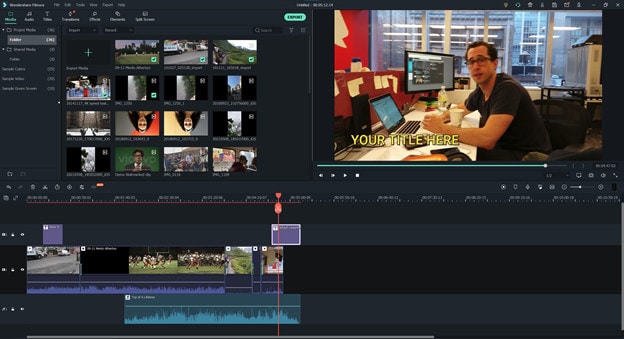
Key features
- Preset Templates
- Instant Mode
- Motion Tracking
- AI Editing Effects
- Auto Synchronization
- Plug-ins
Price
- Annual Plan: $49.99
- Perpetual Plan: $79.99
Pros
- Seamless interface for beginners
- Great customer support
- Plenty of effects and preset templates
- 4K video output options
Cons
- Rendering requires too much time
- The mobile app requires separate subscription
Supported OS: Windows , Mac , iOS , Android , iPad
G2 Ratings: 4.4 stars out of 5
Summary
Filmora’s intuitive interface allows experienced and brand-new users to create incredible videos with flawless special effects. Its high ratings and multiple supported formats make it quite popular among users.
2. Avidemux Video Editor
If you are a beginner and want to use a free, open-source software program for basic video editing, then Avidemux is a good choice. The interface is not as fancy as it could be, but there are some presets that’ll save you a lot of time. Avidemux is a cross-platform video editor that allows you to create custom videos, but it doesn’t feature the ability to share the edited footage to social media directly,
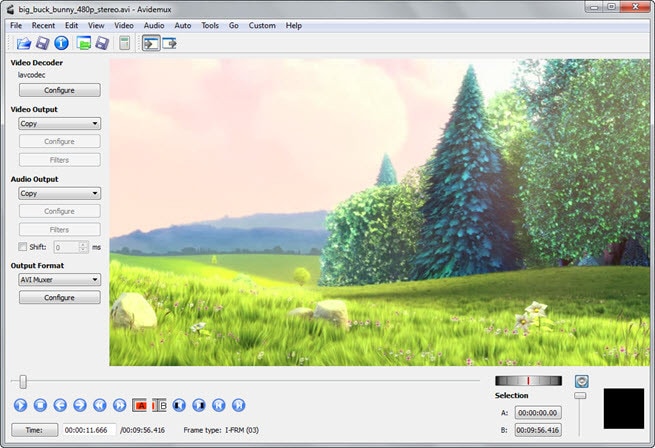
Key features
- Video and Audio Filters
- Support Popular Formats
- Convert Video For Archiving or Publishing
Price: Free
Pros
- It can convert Video To A Smaller Size
- Easy cut, trim, split video
Cons
- Out-dated UI
- Lacks sharing option
Supported OS: Windows , OS X , Linux , BSD
Uptodown Ratings: 4.0 stars out of 5
Summary
An open-source video editor that supports most formats. Due to its obsolete UI and lack of sharing features, Avidemux has average ratings.
3. VirtualDub
This open-source software is user-friendly and allows users with little experience to navigate the software without much trouble. It supports 3rd party apps and also offers batch-processing, which means working on multiple videos simultaneously makes it possible.
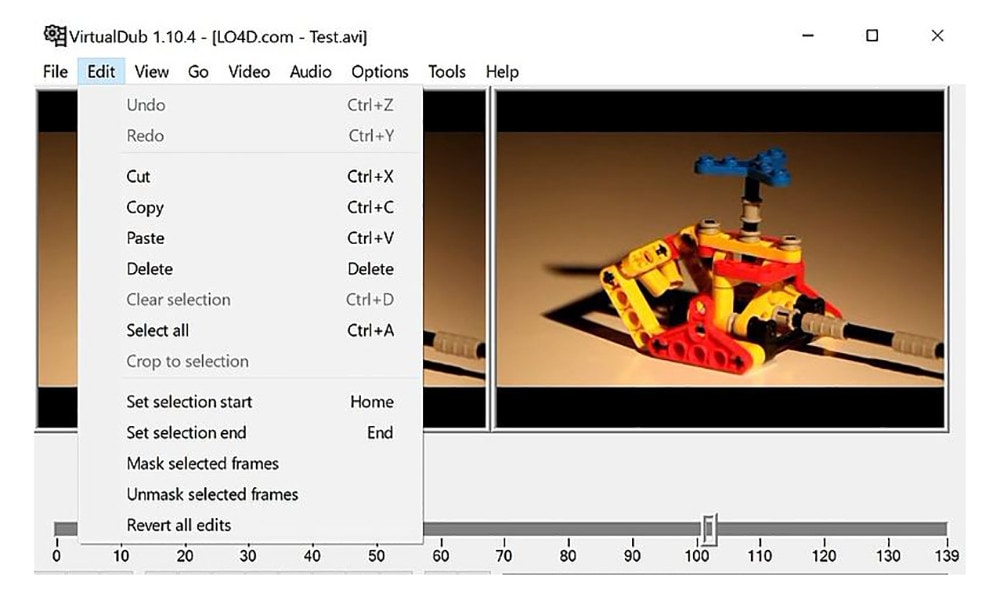
Key features
- Integrated volume and histogram meter
- Optimized disk
- Noise reduction
- Fractional frame rates
Price: Free
Pros
- Clean interface, easy to use
- Keyboard and mouse shortcuts for faster operation
- Free to use
Cons
- Not suitable for 4K editing
- Lack learning material
- Obsolete Interface
Supported OS: Windows
Compare Camp Ratings: 4.0 stars out of 5
Summary
Virtual Dub supports multitasking, and its features are pretty helpful. However, it lacks 4k editing and a friendly interface. Overall Virtual Dub is a good choice.
4. Sony Vegas Movie Studio
This video editing software makes it easy to create professional-looking videos in minimum time and effort. Vegas Movie Studio software is best for video editing professionals who have been doing it for some time and are looking for something a little more sophisticated than free alternatives. Not only does it has a high retail price, but its internal elements can be too complex for those just beginning.
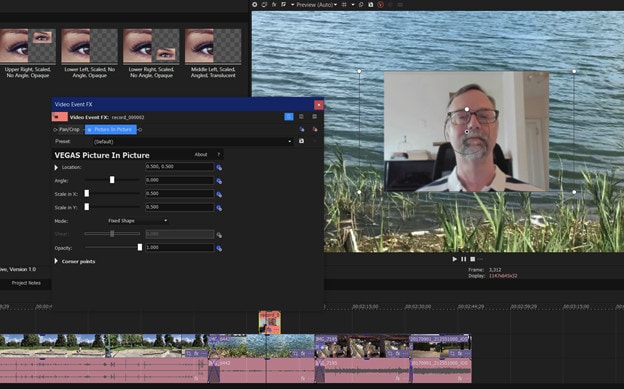
Key features
- Color correction
- HDV and AVCHD-editing
- DV batch capture
- Wide variety of file formats and codecs
Price: Starting from $7.99 USD per month
Pros
- Customizable interface
- Multicam editing
- Lots of effects and transitions, with plug-in capability
- Good slow motion and warp flow transition tools
Cons
- Less intuitive interface than competitors
- Import from camcorder not ideal
- Some tools are complex
Supported OS: Windows
G2 Ratings: 4.4 out of 5
Summary
Vegas Movie Studio is the choice of professionals. It does all the work without taking up a lot of resources, and like most programs, there is a learning curve. It’s not always intuitive for beginners, but its professional and powerful features score decent in most reviews.
5. WeVideo
This cloud-based application is a simple-to-use video editing and sharing suite. WeVideo is a full-featured video editing application that uses JumpStart technology to create amazing videos. It’s an innovative app that offers a seamless editing experience as it supports multiple formats of video, images, audio, and graphics.
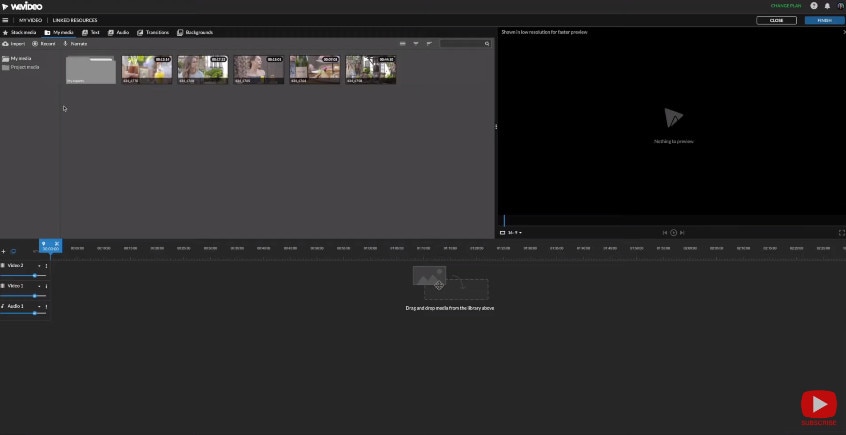
Key features
- WeVideo JumpStart
- Cloud storage
- Built-in graphics
- Customizable environment
- Advanced text editing
- Multi-track editing and storyboard
Price
- Free trial
- Power Plan: $9.99/month
- Unlimited Plan: $15.99/month
- Professional Plan: $39.99/month
- Business Plan: $73.99/month
Pros
- Constantly improving features
- Ease of use
- Storage is cloud-based
Cons
- Old fashion transition
- Leaves a watermark on free trial
Supported OS: Online
Trustpilot Ratings: 4 stars out of 5
Summary
WeVideo is a straightforward yet robust video editor. It offers a variety of features and supports multiple formats, plus its comprehensive pricing plan makes it useful for everyone.
6. Lightworks
Lightworks is the most powerful video editor in its class and an excellent tool for professionals who want to make amazing videos quickly. Lightworks is very fast and straightforward to use, and it has some great features you won’t find in any other video editor. It is available on all popular OS.
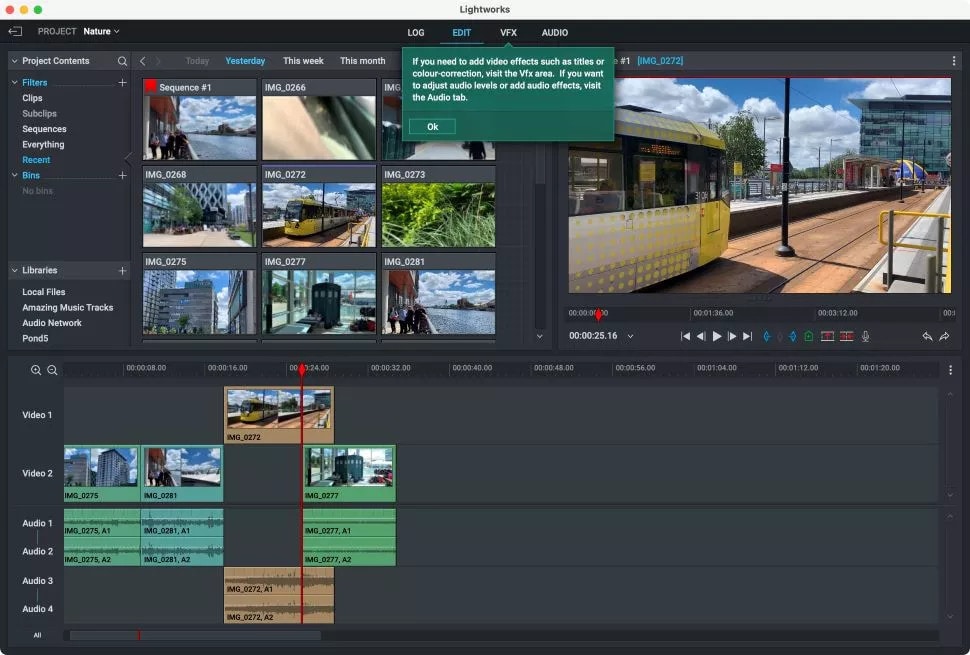
Key features
- Audio and Video Effect Plugin Support
- Cloud Connected
- Motion Graphics
- Advanced Metadata
- Proxy Workflows
- Apple ProRes decoding
Price
- Monthly Plan: $9.99/user
- Yearly Plan: $9.99/user
- Perpetual: $154.99
Pros
- High-resolution timeline rendering
- It has social media export templates
- Interfaces for multiple OS are consistent
- Instant autosave
Cons
- Commands are not always intuitive
- A bit pricey as compared to its competitors
Supported OS: Windows , Mac , Linux
Techradar Pro Ratings: 4 stars out of 5
Summary
Lightworks is not any other video editing tool available on the market of video editing tools. This video editing tool provides amateurs with the most sophisticated features in an optimized platform. Its scores are the highest on almost every review site.
7. ShotCut
Shotcut is a multiplatform video editor that lets you work with various formats for audio, video, image files, etc. This video editor makes it easy to mix and match the resolution and frame rates in a video file. All the changes you make in the editor can be undone and redone often. Shotcut is the best choice for video editing, without question.

Key features
- Webcam capture
- Audio scopes and filters
- Deinterlacing
- Eyedropper tool
- Video wipe transitions
- Keyframes for filter parameters
Price: Free
Pros
- Support for 4K resolutions
- Free
Cons
- Less intuitive than commercial apps
- Lacks built-in sharing to popular sites
Supported OS: Windows , Mac , Linux
GetApp Ratings: 4.5 out of 5 stars
Summary
Shotcut is an open-source video editor for creative professionals and is available on mac, Windows, and Linux. The free version of Shotcut has many excellent features, but it doesn’t have the slick interface or advanced techniques of the top paid editors.
8. OpenShot
An award-winning open-source video editor that creates stunning videos. OpenShot is a fast, easy-to-use, and surprisingly powerful video editor. OpenShot Video Editor allows you to work with many different types of tracks so that your edits will seem natural. OpenShot Video Editor allows you to add your custom animations or titles. The options are endless, so it all depends on your time and interest. It is available in more than 70 languages, making it ideal for all types of users.
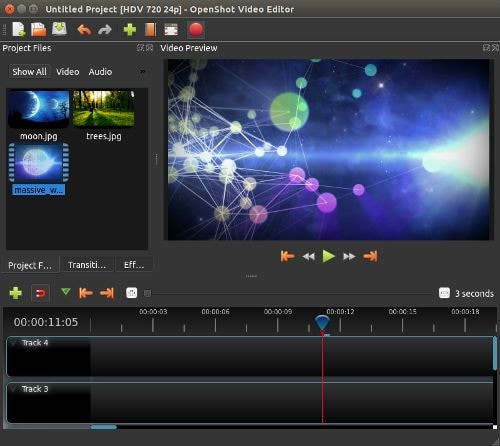
Key features
- 3D animations
- Animation and keyframes
- Multiple languages and formats
- Cross-platform
- Video-effects
Price: Free
Pros
- It is a non-linear editor with infinite tracks
- 100% free without watermark
- Frequent updates
Cons
- Obsolete interface
- Unstable performance
- Lacks some editing features
Supported OS: Window , Mac , Linux , Chrome OS
Getapp Ratings: 4.2 stars out of 5
Summary
Another open-source video-editor in the list is named OpenShot. It’s a multi-lingual and multi-supported app with unique features. Despite its unstable performance, OpenShot is still an ideal choice for many users.
9. Movavi Video Editor Plus
Movavi Video Editor Plus is the perfect tool to bring your creative ideas to life. It has special effects, ready-made intros, and keyframe animation. Using chroma keying, you can change the background of your video clips to any color or pattern that suits your need. Movavi has now redesigned its user interface to make it easy to use.
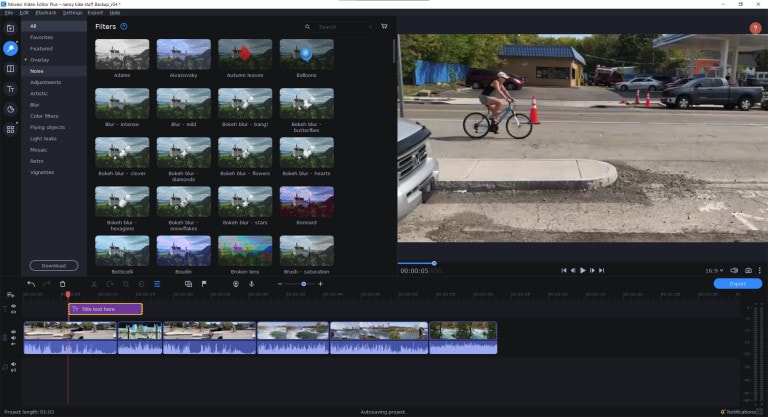
Key features
- Effects and transitions
- Built-in media pack
- Fast processing of 4K videos
- Keyframe animation
- Automatic video creation
- Cutting, trimming, joining
Price
- Free version: 7 days
- Video Editor Plus 1 year /1 PC: $49.95
- Video Editor Plus Lifetime /1 PC: $69.95
- Video Suite Lifetime /1 PC: $89.95
Pros
- Easy-to-understand user interface
- Transitions with sound
- Motion tracking and picture-in-picture tools
- Chroma-key capability
- Quick movie-creation tool
Cons
- Lacks advanced trim modes
- Slow rendering
PCMag Ratings: 4.0 stars out of 5
Summary
If you want to edit your videos with a minimal learning curve, try Movavi. You get PiP, chroma-keying, titling, basic keying, and motion tracking. The program is simple to use but doesn’t have all the features and stands four stars.
10. VSDC Free Video Editor
VSDC Free Video Editor is an online tool that lets you edit audio and video files to make your creations like movies, YouTube tutorial videos, and more. The audio and video files supported are extensive, and the software includes a codec manager. The Pro version isn’t necessary if you’re using the free edition of the software; it’s more than enough to get the job done.
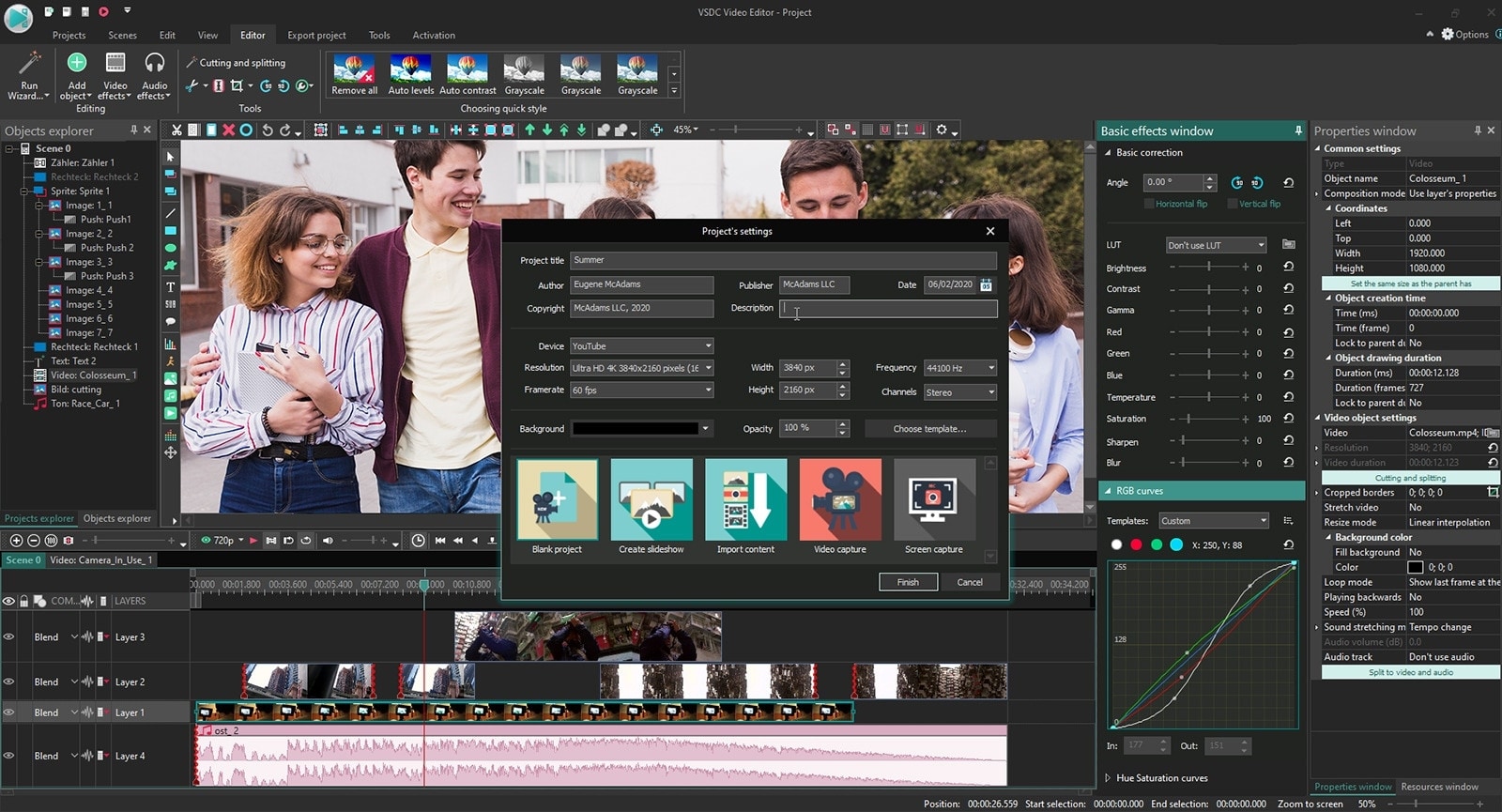
Key features
- Dark theme
- Subpixel Accuracy
- Powerful Chroma Key tool
- Trendy video effects, filters, and transitions
- Color Blending And Filters
- Built-In DVD Burning Tool
Price: Free
Pros
- Non-linear
- Video effects library
- Video stabilization
- Masking
Cons
- Outdated interface
- Lack keyboard shortcuts
- Only available on Windows
Supported OS: Windows
Capterra Ratings: 4.5 stars out 5
Summary
VSDC is a non-linear editor with extensive format support. It includes all the essential features an editor requires but with an obsolete UI. It is also ideal for many who need a powerful yet free video editor.
11. VideoPad Video Editor
VideoPad is a free video editor that can create stunning videos and perform basic editing tasks. A good video editor can help you to create videos for different social media platforms. You can make your videos look professional and polished with a few clicks and some simple editing skills. There’s nothing particularly exciting or advanced about this app; it’s simple enough for anyone new to video editing or even for seasoned editors. But the simple and easy-to-use interface makes the entire process very exciting.
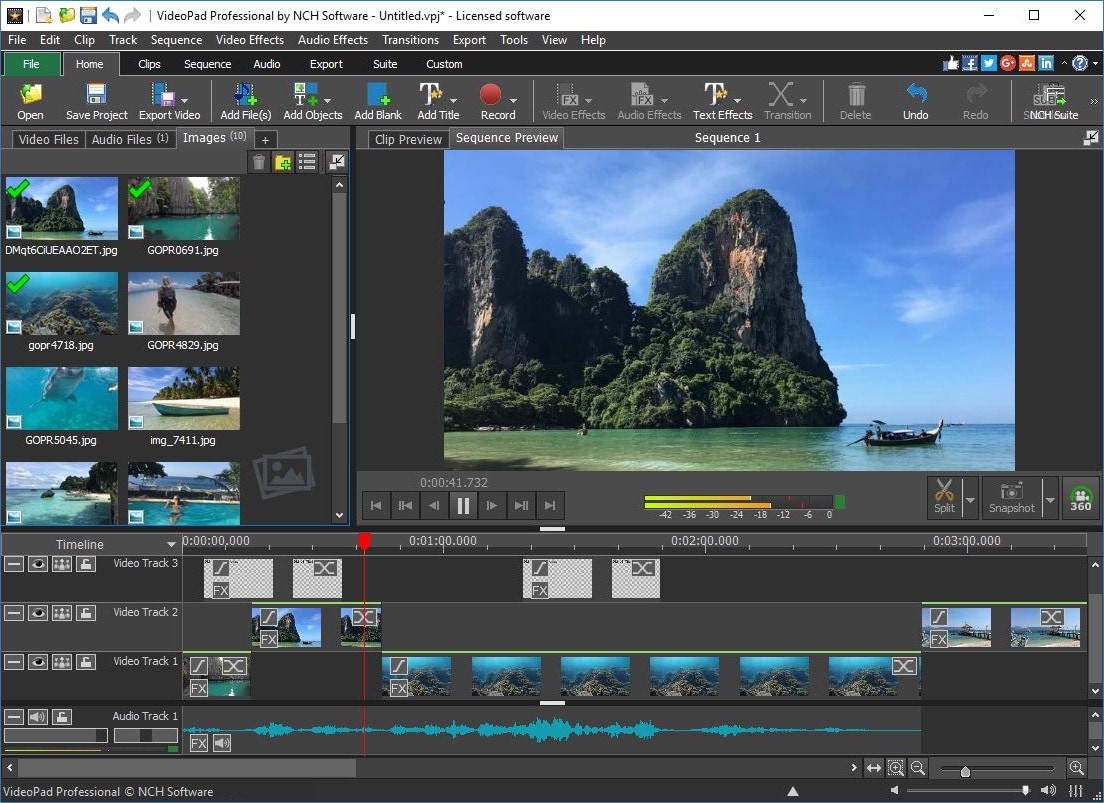
Key features
- Text snippets
- Range of transitional effects
- Plug-ins Library
- Burn finished videos to Blu-Ray, DVD, etc.
- Color correction and light balance.
Price: Free
Pros
- Simple and clean interface
- Supports multiple file formats
- Includes video effects
- Lightweight on system resources
Cons
- Lack of advanced features
Supported OS: Windows , Mac , iPad/iPhone
Tom’s guide Ratings: 3.5 stars out of 5
Summary
Video pad is a free video editor designed for beginners that is lightweight and simple. VideoPad is also great for creating quick videos for social media purposes like Youtube and Facebook. The software has a high rating, as shown above, and it’s available on Windows.
12. HitFilm
HitFilm is a helpful video editing software that makes editing easier for users. In addition to basic features, the program also provides advanced-level functions that make edited videos pop. Hitfilm Express Download has more than 400 features to help casual video editors save time. Features like: visual effects, cinematic elements, and compositing tools preset help unleash your creativity.
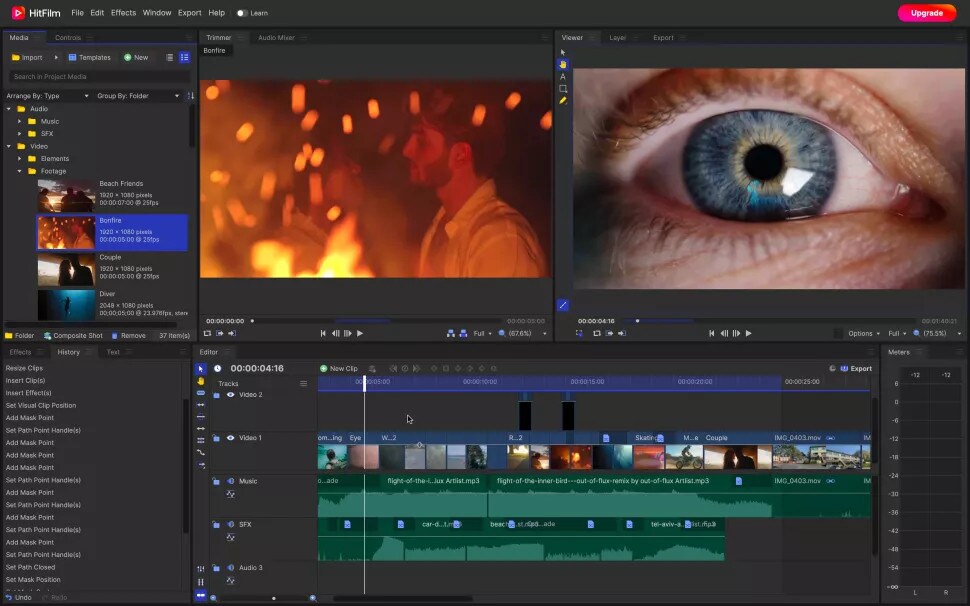
Key features
- Color Grading and correction
- Smart search
- Commentator recorder
- Lightning and lens flares
- 3D camera tracker
Price
- Free trial
- Creator: $7.50
- Pro: $12.50
- Enterprise: Custom pricing
Pros
- Intuitive interface
- It offers free tutorials and masterclasses
- Works on both Windows and Mac
Cons
- It requires heavy system requirements
TechRadar Ratings: 4.5 stars out of 5
Summary
HitFilm Express 15 is a powerful free video editing program that enables you to create high-quality videos in minutes with an intuitive interface. It offers advanced editing features such as advanced video trimming, 3D editing, and more.
13. Magix Movie Studio
Magix is the world’s leading professional audiovisual media software, with Sequoia being its industry-standard audio editing software. This movie editor is an enthusiast-level video editing software that competes with software from Adobe and CyberLink, and it even boasts support for 4K content and 360 degrees. There are many reasons to upgrade. This year’s update includes stabilization, 8K editing, motion tracking, and an in-app plug-in store.
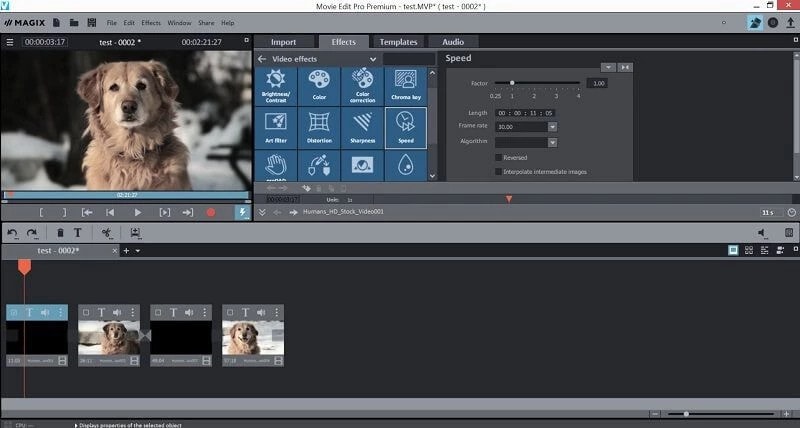
Key features
- NewBlue effects
- Fly-in animation
- New filter view
- Stabilization
- Motion tracking
- 8k support
Price
- Movie Studio 2024: $69.99 (30-day free trial)
- Movie Studio 2024 Platinum: $99.99 (30-day free trial)
- Movie Studio 2024 Suite: $129.00 (30-day free trial)
Pros
- Lots of video effects
- Responsive editing interface
- Multicam
- Trailer-like movie templates
- Solid audio editing
Cons
- Slower project rendering than others
- Lacks import and organization tools
Supported OS: Windows
PCMag Ratings: 3 stars out of 5
Summary
Magix movie studio is a powerful all-around video editing tool with many features that professional users have come to expect. It’s also relatively simple to use. But usability and performance are poor compared to other software programs like Filmora .
Part 4: How To Edit a Video With a Windows Movie Maker Alternative
Windows Movie Maker was great for editing a video, but it’s no match for some of the best video editing software. We’re talking about software capable of creating a cinematic experience in seconds, all on your computer.
When you need to edit a video with simple, quick edits, like adding a special effect or changing the background, try Filmora . Filmora is an easy-to-use application that allows you to create a movie using simple tools that don’t require additional training. You can’t beat this option if you want to create a professional-quality video for your blog or website.
Let’s dive into a quick tutorial on editing videos in Filmora:
Free Download For Win 7 or later(64-bit)
Free Download For macOS 10.14 or later
Step1 Open Wondershare Filmora on your PC or Mac
You can start a new project by clicking on ‘New Project’. And you can also change the ‘Aspect Ratio’ according to your project demand.

Step2 Import Videos
You can import your file by clicking the import tab on the upper-left side or clicking the import icon on the main window.
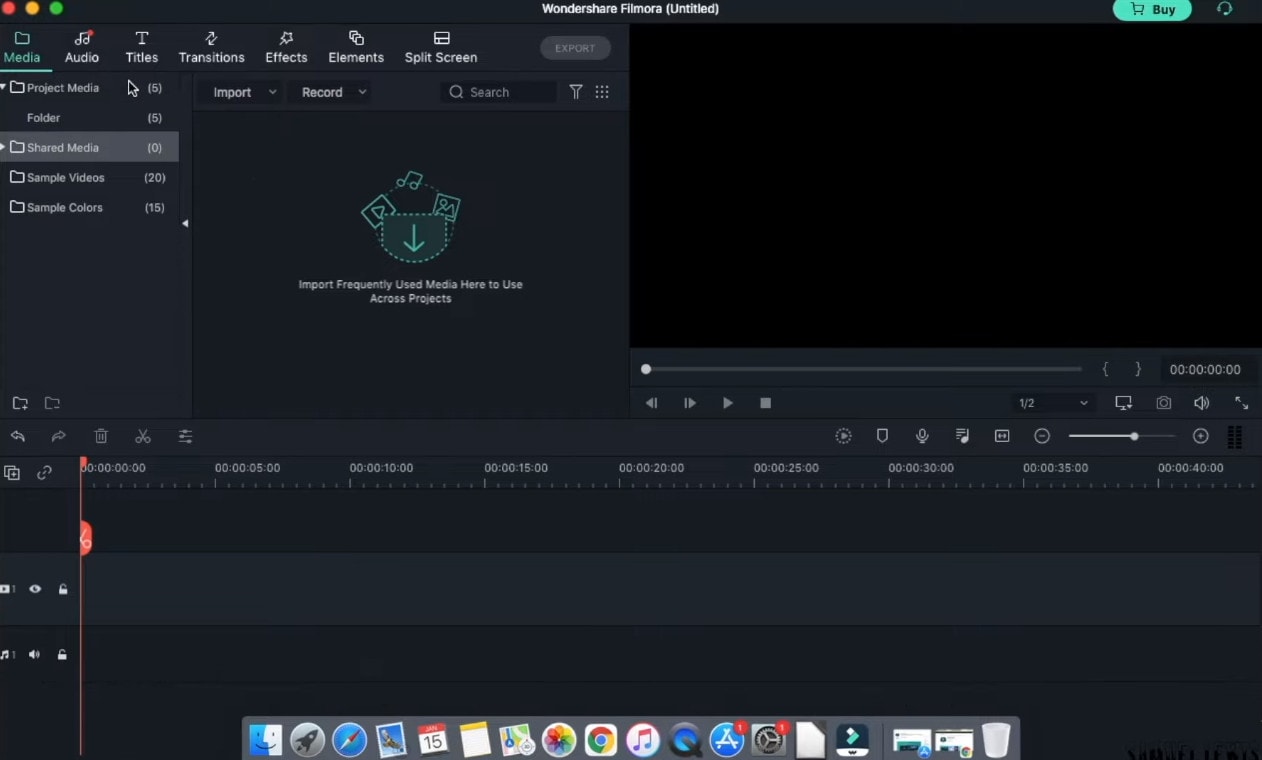
Step3 Drag and drop your footage to the timeline
After importing all the files, click and hold each individual video and drag and drop it to the timeline area according to your ideal sequence.
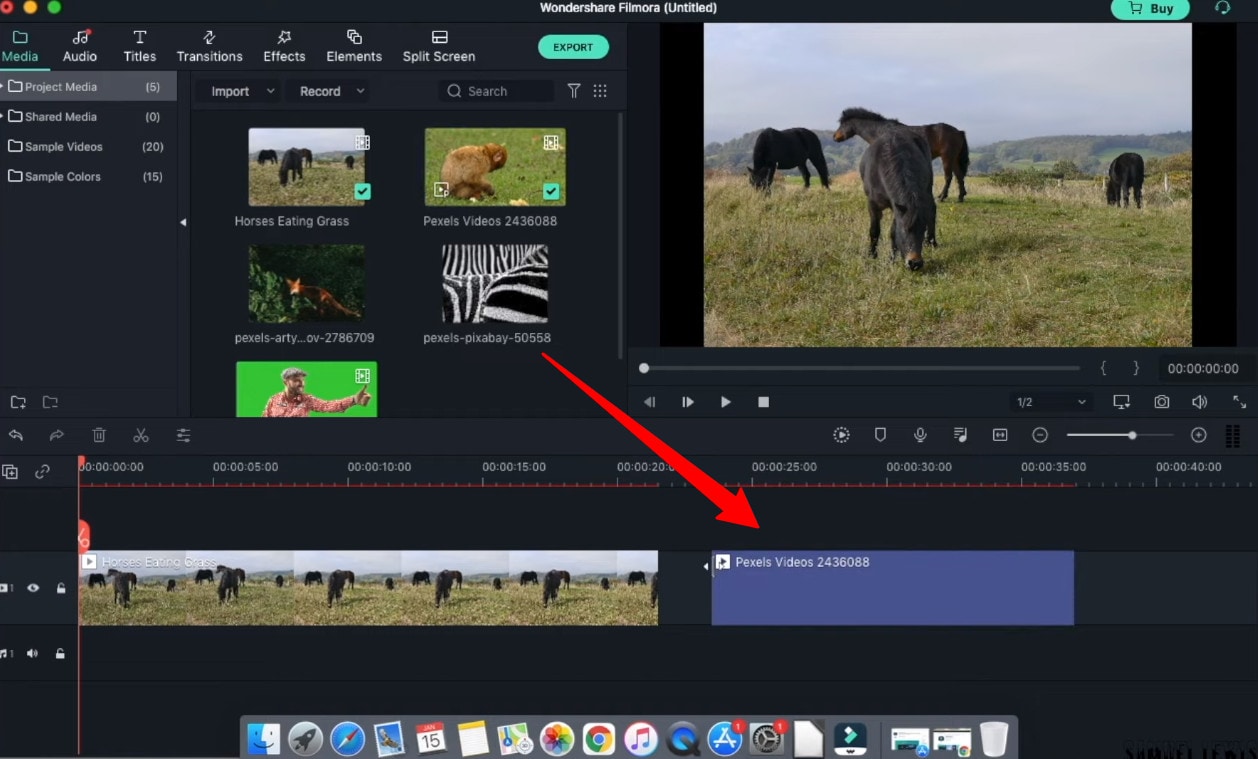
Step4 Add Audio
Go to the ‘Audio’ tab and select the audio file from the audio library. Once selected, drag and drop the audio file into the music timeline.
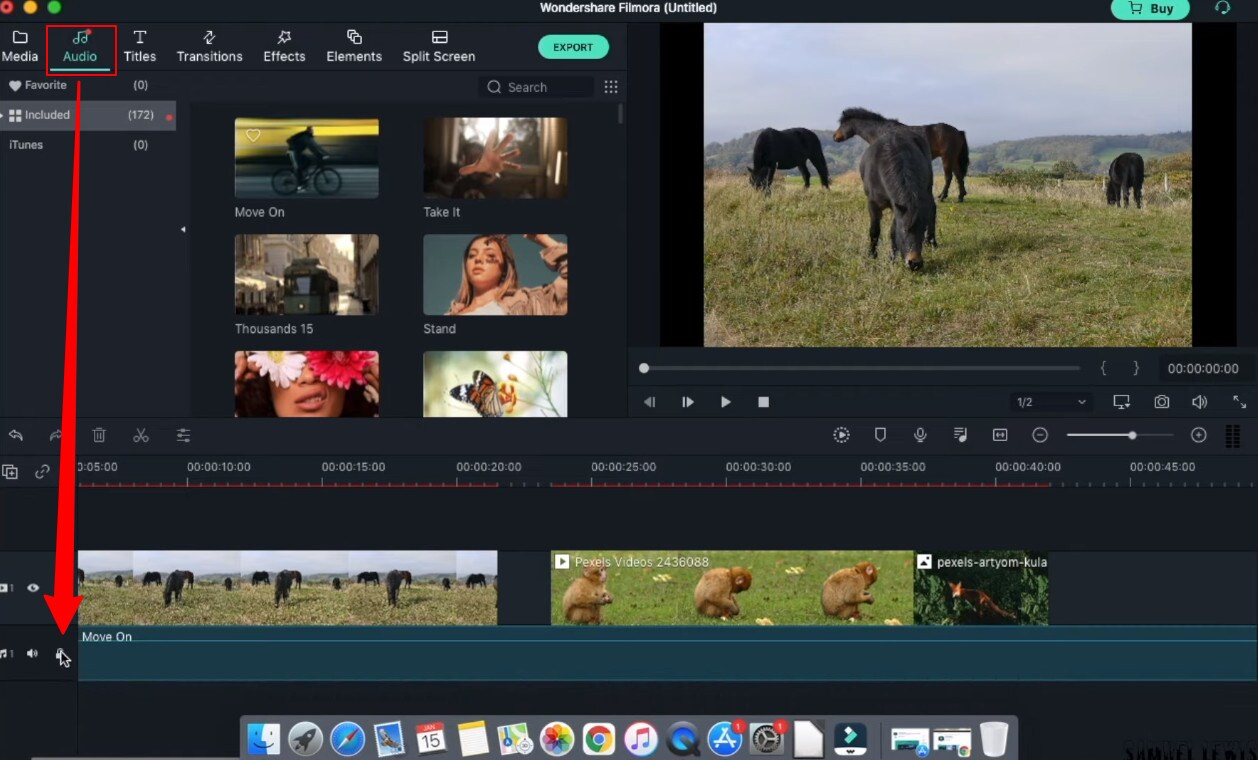
Step5 Add Titles
In your video intro, you can insert some title text. Go to the ‘Titles’ tab and select the one you like, and drag and drop it on top of the timeline. Double-click and edit the text and state your ideal statements. You can customize your text fonts and color too.
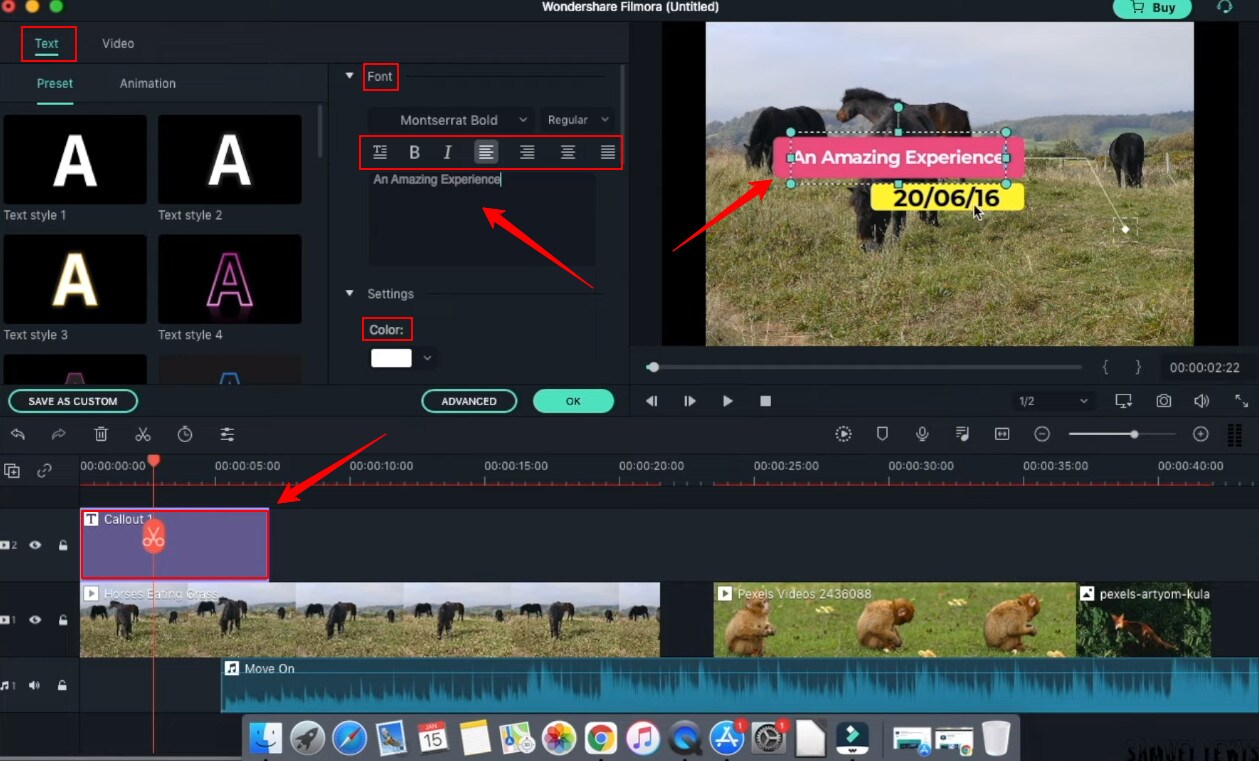
Step6 Add Transitions
You can add transition effects to ensure a smooth transition from one scene to another. The overall will get more professional look.

Step7 Add Effects
Next; you can get special effects to your video to make them more attractive and engaging to watch. Simple drag down the effect to your video and watch the effect take place in your selective scene.
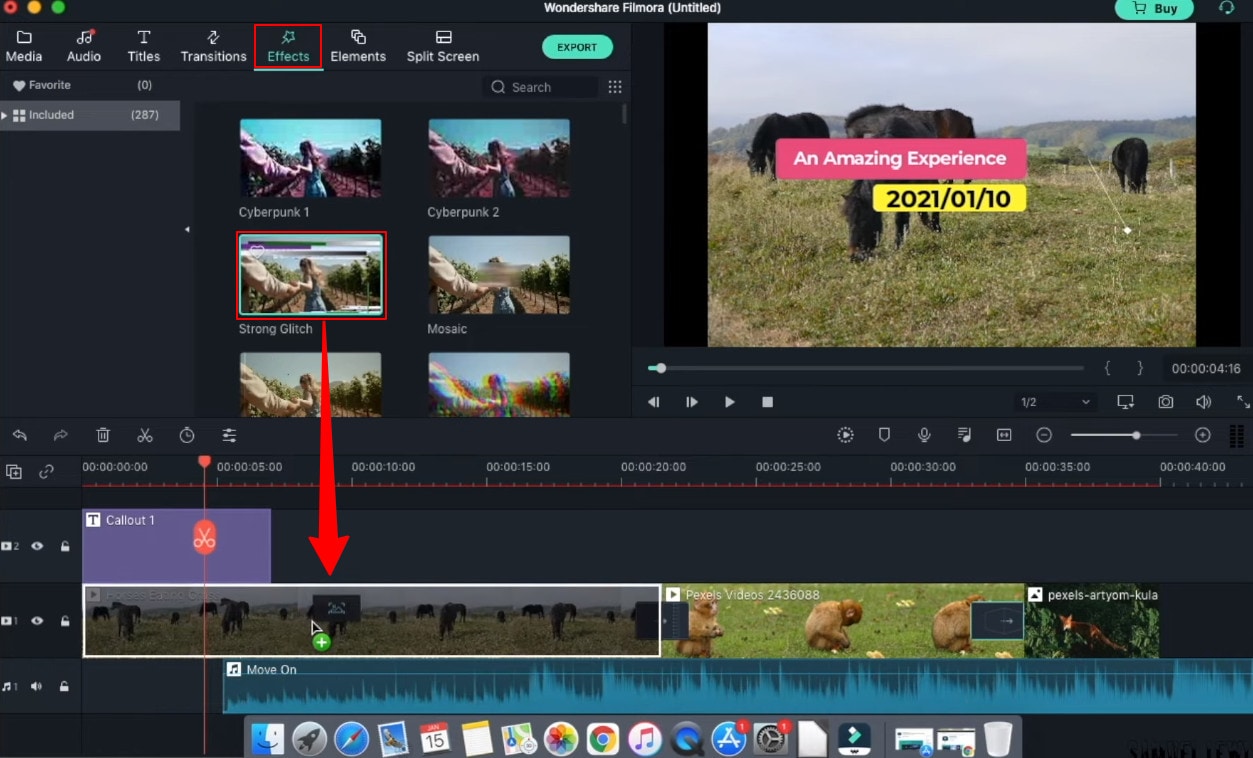
Step8 Export your work
Once all the changes have been made, hit ‘export’ from the top tab. A window will appear where you can change the settings, resolution, frame rate, bit rate, etc. Next, click the ‘export’ button down on that window, and then you can save the file in your drive.
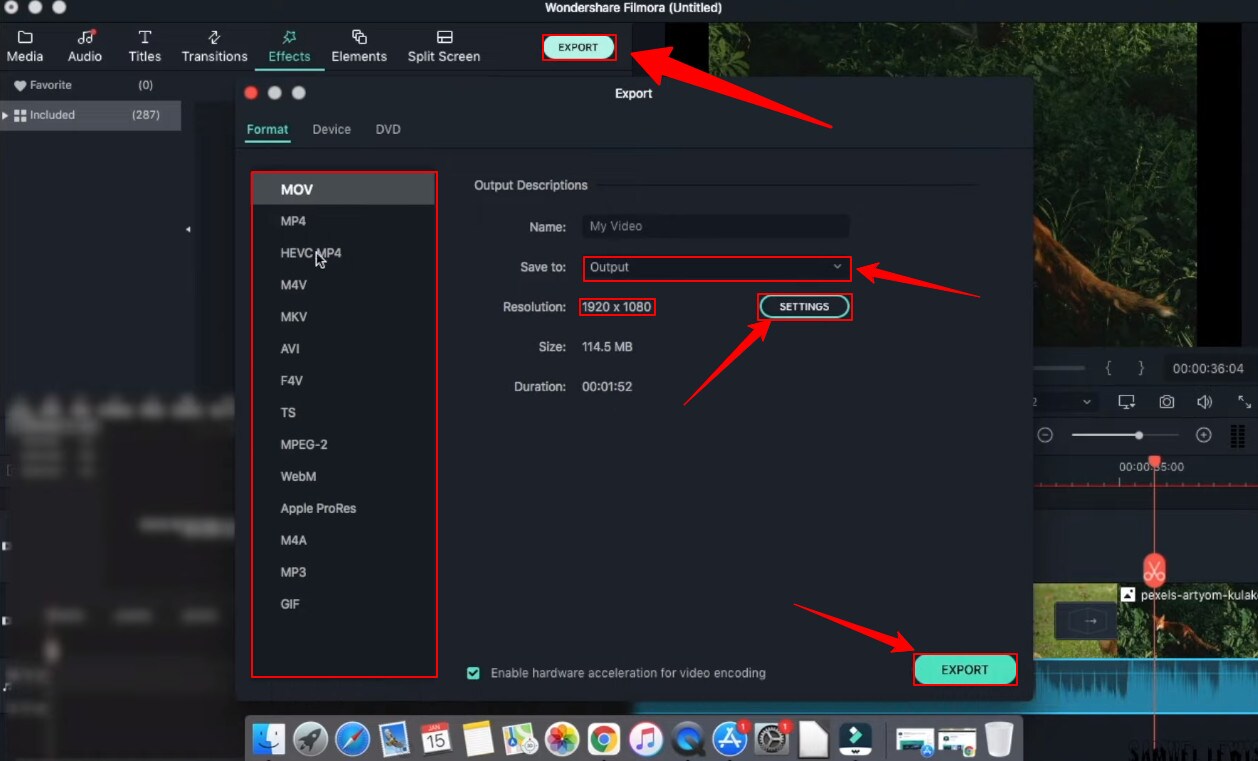
Part 5: Hot FAQs on Windows Movie Maker Alternatives
1. Why is Windows Movie Maker discontinued?
Microsoft’s video editing program, Windows Movie Maker, did not become a big hit with the public because it failed to do well on the market. Microsoft couldn’t get the support they were looking for from the program’s users. As a result, Microsoft had to cease its support of the program.
2. Is there a free version of Windows Movie Maker?
Microsoft Windows Movie maker was always accessible and pre-installed every windows product. Microsoft has discontinued support for Movie Maker and warns about free downloads of Movie Maker provided by third parties that might contain malware, viruses, or other issues.
3. What are the best free Windows Movie Maker Alternatives for Mac?
After switching to a Mac, you’ll find that the Windows Movie Maker alternatives offer much more than just a simple video editor. They provide advanced features, easy transitions, and less technical know-how to create pro-quality results. You should try using these platforms on your Mac if you have a video to edit.
- Wondershare Filmora
- Movavi
- OpenShot
Final Words
Windows Movie Maker is an excellent Windows video editor application for Windows users. But in recent years, it has become outdated due to the continuous development of new technologies. There are many alternatives for Windows Movie Maker, and here we listed some of the best ones. Most of them are free and featured packs. Each program has its unique set of features and capabilities, and each one excels in different areas. Check them out and see what you think.
Free Download For Win 7 or later(64-bit)
Free Download For macOS 10.14 or later
Part 1: Top 3 Picks for Windows Movie Maker Alternatives
The world’s best video editing software is about to change. We look at three of the most popular and valuable alternatives to Windows Movie Maker.
You will need to consider these alternatives to ensure they meet your expectations and needs.
1. Wondershare Filmora - Best Overall

Filmora is the best Windows Movie Maker Alternative designed according to your convenience.
Ratings: 4.4 Stars out 5
Starting from $49.99
2. Magix Movie Studio - Best for Collages

This alternative offers a variety of tools and plugins for anyone who wants to create professional-level videos in under a minute.
Download on Windows
Ratings: 4 stars out of 5
30-day free trials, then starts from $69.99 all the way to $129
3. Avidemux Video Editor - Best Open-Source Editor

An open-source editor that supports a wide range of formats is free! Avidemux has an interface similar to Windows Movie Maker, which makes it a perfect alternative.
Download on Windows
Ratings: 4.0 stars out of 5
Free Trial
Part 2: Ultimate Overview on 13 Best Alternatives to Windows Movie Maker
We live in visual culture, and we constantly see, capture, upload, and share videos on our smartphones, tablets, and laptops. So, it is only natural that more people seek ways to edit their videos. Windows Movie Maker was one of the most popular video editing apps. So it’s time to dig into the best Windows Movie Maker alternatives, which are arguably better and feature-rich.
| Software | OS | Media Resources | AI editing | Easy to Use | Free Trial |
|---|---|---|---|---|---|
| Wondershare Filmora | WindowsMacMobile | Yes | Yes | Yes | Yes |
| Avidemux | WindowsOS XLinuxBSD | Yes | No | Yes | Yes |
| Virtual Dub | Windows | No | No | Yes | Yes |
| Vegas Movie Studio | Windows | Yes | Yes | No | No |
| WeVideo | Online | Yes | No | Yes | Yes |
| Lightworks | LinuxOS X Windows | Yes | Yes | No | No |
| ShotCut | WindowsMacLinuxBSD | Yes | No | No | Yes |
| OpenShot | WindowsMacLinuxChrome OS | Yes | No | Yes | Yes |
| Movavi Plus | WindowsMac | Yes | No | Yes | Yes |
| VSDC | Windows | Yes | No | Yes | Yes |
| VideoPad | WindowsMaciPad/iPhone | Yes | No | Yes | Yes |
| HitFilm | WindowsMac | Yes | Yes | Yes | Yes |
| Magix Movie Studio | Windows | Yes | Yes | No | Yes |
Part 3: 13 Best Windows Movie Maker Alternatives for Windows
As we all know, Windows Movie Maker is the most used and trusted tool for creating videos in Windows. With its unique features and user-friendly interface, people often use this software to develop short and entertaining videos.
However, the fact is that Windows Movie Maker is not the current best video editing software for creating complex video projects. For this reason, we compiled a list of the 12 best alternatives to offer you a better option for Windows Movie Maker.
1. Wondershare Filmora
Filmora 11 is a powerful, easy-to-use video editor specially designed to streamline your workflow and save you hours weekly. It supports everything from Windows, Mac, and IOS to Android. The latest update to the flagship app includes several key enhancements that result in a much more efficient video creation workflow and one that’s easier to use than its rivals.

Key features
- Preset Templates
- Instant Mode
- Motion Tracking
- AI Editing Effects
- Auto Synchronization
- Plug-ins
Price
- Annual Plan: $49.99
- Perpetual Plan: $79.99
Pros
- Seamless interface for beginners
- Great customer support
- Plenty of effects and preset templates
- 4K video output options
Cons
- Rendering requires too much time
- The mobile app requires separate subscription
Supported OS: Windows , Mac , iOS , Android , iPad
G2 Ratings: 4.4 stars out of 5
Summary
Filmora’s intuitive interface allows experienced and brand-new users to create incredible videos with flawless special effects. Its high ratings and multiple supported formats make it quite popular among users.
2. Avidemux Video Editor
If you are a beginner and want to use a free, open-source software program for basic video editing, then Avidemux is a good choice. The interface is not as fancy as it could be, but there are some presets that’ll save you a lot of time. Avidemux is a cross-platform video editor that allows you to create custom videos, but it doesn’t feature the ability to share the edited footage to social media directly,

Key features
- Video and Audio Filters
- Support Popular Formats
- Convert Video For Archiving or Publishing
Price: Free
Pros
- It can convert Video To A Smaller Size
- Easy cut, trim, split video
Cons
- Out-dated UI
- Lacks sharing option
Supported OS: Windows , OS X , Linux , BSD
Uptodown Ratings: 4.0 stars out of 5
Summary
An open-source video editor that supports most formats. Due to its obsolete UI and lack of sharing features, Avidemux has average ratings.
3. VirtualDub
This open-source software is user-friendly and allows users with little experience to navigate the software without much trouble. It supports 3rd party apps and also offers batch-processing, which means working on multiple videos simultaneously makes it possible.

Key features
- Integrated volume and histogram meter
- Optimized disk
- Noise reduction
- Fractional frame rates
Price: Free
Pros
- Clean interface, easy to use
- Keyboard and mouse shortcuts for faster operation
- Free to use
Cons
- Not suitable for 4K editing
- Lack learning material
- Obsolete Interface
Supported OS: Windows
Compare Camp Ratings: 4.0 stars out of 5
Summary
Virtual Dub supports multitasking, and its features are pretty helpful. However, it lacks 4k editing and a friendly interface. Overall Virtual Dub is a good choice.
4. Sony Vegas Movie Studio
This video editing software makes it easy to create professional-looking videos in minimum time and effort. Vegas Movie Studio software is best for video editing professionals who have been doing it for some time and are looking for something a little more sophisticated than free alternatives. Not only does it has a high retail price, but its internal elements can be too complex for those just beginning.

Key features
- Color correction
- HDV and AVCHD-editing
- DV batch capture
- Wide variety of file formats and codecs
Price: Starting from $7.99 USD per month
Pros
- Customizable interface
- Multicam editing
- Lots of effects and transitions, with plug-in capability
- Good slow motion and warp flow transition tools
Cons
- Less intuitive interface than competitors
- Import from camcorder not ideal
- Some tools are complex
Supported OS: Windows
G2 Ratings: 4.4 out of 5
Summary
Vegas Movie Studio is the choice of professionals. It does all the work without taking up a lot of resources, and like most programs, there is a learning curve. It’s not always intuitive for beginners, but its professional and powerful features score decent in most reviews.
5. WeVideo
This cloud-based application is a simple-to-use video editing and sharing suite. WeVideo is a full-featured video editing application that uses JumpStart technology to create amazing videos. It’s an innovative app that offers a seamless editing experience as it supports multiple formats of video, images, audio, and graphics.

Key features
- WeVideo JumpStart
- Cloud storage
- Built-in graphics
- Customizable environment
- Advanced text editing
- Multi-track editing and storyboard
Price
- Free trial
- Power Plan: $9.99/month
- Unlimited Plan: $15.99/month
- Professional Plan: $39.99/month
- Business Plan: $73.99/month
Pros
- Constantly improving features
- Ease of use
- Storage is cloud-based
Cons
- Old fashion transition
- Leaves a watermark on free trial
Supported OS: Online
Trustpilot Ratings: 4 stars out of 5
Summary
WeVideo is a straightforward yet robust video editor. It offers a variety of features and supports multiple formats, plus its comprehensive pricing plan makes it useful for everyone.
6. Lightworks
Lightworks is the most powerful video editor in its class and an excellent tool for professionals who want to make amazing videos quickly. Lightworks is very fast and straightforward to use, and it has some great features you won’t find in any other video editor. It is available on all popular OS.

Key features
- Audio and Video Effect Plugin Support
- Cloud Connected
- Motion Graphics
- Advanced Metadata
- Proxy Workflows
- Apple ProRes decoding
Price
- Monthly Plan: $9.99/user
- Yearly Plan: $9.99/user
- Perpetual: $154.99
Pros
- High-resolution timeline rendering
- It has social media export templates
- Interfaces for multiple OS are consistent
- Instant autosave
Cons
- Commands are not always intuitive
- A bit pricey as compared to its competitors
Supported OS: Windows , Mac , Linux
Techradar Pro Ratings: 4 stars out of 5
Summary
Lightworks is not any other video editing tool available on the market of video editing tools. This video editing tool provides amateurs with the most sophisticated features in an optimized platform. Its scores are the highest on almost every review site.
7. ShotCut
Shotcut is a multiplatform video editor that lets you work with various formats for audio, video, image files, etc. This video editor makes it easy to mix and match the resolution and frame rates in a video file. All the changes you make in the editor can be undone and redone often. Shotcut is the best choice for video editing, without question.

Key features
- Webcam capture
- Audio scopes and filters
- Deinterlacing
- Eyedropper tool
- Video wipe transitions
- Keyframes for filter parameters
Price: Free
Pros
- Support for 4K resolutions
- Free
Cons
- Less intuitive than commercial apps
- Lacks built-in sharing to popular sites
Supported OS: Windows , Mac , Linux
GetApp Ratings: 4.5 out of 5 stars
Summary
Shotcut is an open-source video editor for creative professionals and is available on mac, Windows, and Linux. The free version of Shotcut has many excellent features, but it doesn’t have the slick interface or advanced techniques of the top paid editors.
8. OpenShot
An award-winning open-source video editor that creates stunning videos. OpenShot is a fast, easy-to-use, and surprisingly powerful video editor. OpenShot Video Editor allows you to work with many different types of tracks so that your edits will seem natural. OpenShot Video Editor allows you to add your custom animations or titles. The options are endless, so it all depends on your time and interest. It is available in more than 70 languages, making it ideal for all types of users.

Key features
- 3D animations
- Animation and keyframes
- Multiple languages and formats
- Cross-platform
- Video-effects
Price: Free
Pros
- It is a non-linear editor with infinite tracks
- 100% free without watermark
- Frequent updates
Cons
- Obsolete interface
- Unstable performance
- Lacks some editing features
Supported OS: Window , Mac , Linux , Chrome OS
Getapp Ratings: 4.2 stars out of 5
Summary
Another open-source video-editor in the list is named OpenShot. It’s a multi-lingual and multi-supported app with unique features. Despite its unstable performance, OpenShot is still an ideal choice for many users.
9. Movavi Video Editor Plus
Movavi Video Editor Plus is the perfect tool to bring your creative ideas to life. It has special effects, ready-made intros, and keyframe animation. Using chroma keying, you can change the background of your video clips to any color or pattern that suits your need. Movavi has now redesigned its user interface to make it easy to use.

Key features
- Effects and transitions
- Built-in media pack
- Fast processing of 4K videos
- Keyframe animation
- Automatic video creation
- Cutting, trimming, joining
Price
- Free version: 7 days
- Video Editor Plus 1 year /1 PC: $49.95
- Video Editor Plus Lifetime /1 PC: $69.95
- Video Suite Lifetime /1 PC: $89.95
Pros
- Easy-to-understand user interface
- Transitions with sound
- Motion tracking and picture-in-picture tools
- Chroma-key capability
- Quick movie-creation tool
Cons
- Lacks advanced trim modes
- Slow rendering
PCMag Ratings: 4.0 stars out of 5
Summary
If you want to edit your videos with a minimal learning curve, try Movavi. You get PiP, chroma-keying, titling, basic keying, and motion tracking. The program is simple to use but doesn’t have all the features and stands four stars.
10. VSDC Free Video Editor
VSDC Free Video Editor is an online tool that lets you edit audio and video files to make your creations like movies, YouTube tutorial videos, and more. The audio and video files supported are extensive, and the software includes a codec manager. The Pro version isn’t necessary if you’re using the free edition of the software; it’s more than enough to get the job done.

Key features
- Dark theme
- Subpixel Accuracy
- Powerful Chroma Key tool
- Trendy video effects, filters, and transitions
- Color Blending And Filters
- Built-In DVD Burning Tool
Price: Free
Pros
- Non-linear
- Video effects library
- Video stabilization
- Masking
Cons
- Outdated interface
- Lack keyboard shortcuts
- Only available on Windows
Supported OS: Windows
Capterra Ratings: 4.5 stars out 5
Summary
VSDC is a non-linear editor with extensive format support. It includes all the essential features an editor requires but with an obsolete UI. It is also ideal for many who need a powerful yet free video editor.
11. VideoPad Video Editor
VideoPad is a free video editor that can create stunning videos and perform basic editing tasks. A good video editor can help you to create videos for different social media platforms. You can make your videos look professional and polished with a few clicks and some simple editing skills. There’s nothing particularly exciting or advanced about this app; it’s simple enough for anyone new to video editing or even for seasoned editors. But the simple and easy-to-use interface makes the entire process very exciting.

Key features
- Text snippets
- Range of transitional effects
- Plug-ins Library
- Burn finished videos to Blu-Ray, DVD, etc.
- Color correction and light balance.
Price: Free
Pros
- Simple and clean interface
- Supports multiple file formats
- Includes video effects
- Lightweight on system resources
Cons
- Lack of advanced features
Supported OS: Windows , Mac , iPad/iPhone
Tom’s guide Ratings: 3.5 stars out of 5
Summary
Video pad is a free video editor designed for beginners that is lightweight and simple. VideoPad is also great for creating quick videos for social media purposes like Youtube and Facebook. The software has a high rating, as shown above, and it’s available on Windows.
12. HitFilm
HitFilm is a helpful video editing software that makes editing easier for users. In addition to basic features, the program also provides advanced-level functions that make edited videos pop. Hitfilm Express Download has more than 400 features to help casual video editors save time. Features like: visual effects, cinematic elements, and compositing tools preset help unleash your creativity.

Key features
- Color Grading and correction
- Smart search
- Commentator recorder
- Lightning and lens flares
- 3D camera tracker
Price
- Free trial
- Creator: $7.50
- Pro: $12.50
- Enterprise: Custom pricing
Pros
- Intuitive interface
- It offers free tutorials and masterclasses
- Works on both Windows and Mac
Cons
- It requires heavy system requirements
TechRadar Ratings: 4.5 stars out of 5
Summary
HitFilm Express 15 is a powerful free video editing program that enables you to create high-quality videos in minutes with an intuitive interface. It offers advanced editing features such as advanced video trimming, 3D editing, and more.
13. Magix Movie Studio
Magix is the world’s leading professional audiovisual media software, with Sequoia being its industry-standard audio editing software. This movie editor is an enthusiast-level video editing software that competes with software from Adobe and CyberLink, and it even boasts support for 4K content and 360 degrees. There are many reasons to upgrade. This year’s update includes stabilization, 8K editing, motion tracking, and an in-app plug-in store.

Key features
- NewBlue effects
- Fly-in animation
- New filter view
- Stabilization
- Motion tracking
- 8k support
Price
- Movie Studio 2024: $69.99 (30-day free trial)
- Movie Studio 2024 Platinum: $99.99 (30-day free trial)
- Movie Studio 2024 Suite: $129.00 (30-day free trial)
Pros
- Lots of video effects
- Responsive editing interface
- Multicam
- Trailer-like movie templates
- Solid audio editing
Cons
- Slower project rendering than others
- Lacks import and organization tools
Supported OS: Windows
PCMag Ratings: 3 stars out of 5
Summary
Magix movie studio is a powerful all-around video editing tool with many features that professional users have come to expect. It’s also relatively simple to use. But usability and performance are poor compared to other software programs like Filmora .
Part 4: How To Edit a Video With a Windows Movie Maker Alternative
Windows Movie Maker was great for editing a video, but it’s no match for some of the best video editing software. We’re talking about software capable of creating a cinematic experience in seconds, all on your computer.
When you need to edit a video with simple, quick edits, like adding a special effect or changing the background, try Filmora . Filmora is an easy-to-use application that allows you to create a movie using simple tools that don’t require additional training. You can’t beat this option if you want to create a professional-quality video for your blog or website.
Let’s dive into a quick tutorial on editing videos in Filmora:
Free Download For Win 7 or later(64-bit)
Free Download For macOS 10.14 or later
Step1 Open Wondershare Filmora on your PC or Mac
You can start a new project by clicking on ‘New Project’. And you can also change the ‘Aspect Ratio’ according to your project demand.

Step2 Import Videos
You can import your file by clicking the import tab on the upper-left side or clicking the import icon on the main window.

Step3 Drag and drop your footage to the timeline
After importing all the files, click and hold each individual video and drag and drop it to the timeline area according to your ideal sequence.

Step4 Add Audio
Go to the ‘Audio’ tab and select the audio file from the audio library. Once selected, drag and drop the audio file into the music timeline.

Step5 Add Titles
In your video intro, you can insert some title text. Go to the ‘Titles’ tab and select the one you like, and drag and drop it on top of the timeline. Double-click and edit the text and state your ideal statements. You can customize your text fonts and color too.

Step6 Add Transitions
You can add transition effects to ensure a smooth transition from one scene to another. The overall will get more professional look.

Step7 Add Effects
Next; you can get special effects to your video to make them more attractive and engaging to watch. Simple drag down the effect to your video and watch the effect take place in your selective scene.

Step8 Export your work
Once all the changes have been made, hit ‘export’ from the top tab. A window will appear where you can change the settings, resolution, frame rate, bit rate, etc. Next, click the ‘export’ button down on that window, and then you can save the file in your drive.

Part 5: Hot FAQs on Windows Movie Maker Alternatives
1. Why is Windows Movie Maker discontinued?
Microsoft’s video editing program, Windows Movie Maker, did not become a big hit with the public because it failed to do well on the market. Microsoft couldn’t get the support they were looking for from the program’s users. As a result, Microsoft had to cease its support of the program.
2. Is there a free version of Windows Movie Maker?
Microsoft Windows Movie maker was always accessible and pre-installed every windows product. Microsoft has discontinued support for Movie Maker and warns about free downloads of Movie Maker provided by third parties that might contain malware, viruses, or other issues.
3. What are the best free Windows Movie Maker Alternatives for Mac?
After switching to a Mac, you’ll find that the Windows Movie Maker alternatives offer much more than just a simple video editor. They provide advanced features, easy transitions, and less technical know-how to create pro-quality results. You should try using these platforms on your Mac if you have a video to edit.
- Wondershare Filmora
- Movavi
- OpenShot
Final Words
Windows Movie Maker is an excellent Windows video editor application for Windows users. But in recent years, it has become outdated due to the continuous development of new technologies. There are many alternatives for Windows Movie Maker, and here we listed some of the best ones. Most of them are free and featured packs. Each program has its unique set of features and capabilities, and each one excels in different areas. Check them out and see what you think.
Free Download For Win 7 or later(64-bit)
Free Download For macOS 10.14 or later
Change Video Aspect Ratio in Final Cut Pro: Easy Instructions for Beginners
Wondershare Filmora
Create stunning effects with simple clicks.
Most of you must be wondering what is the purpose of changing the aspect ratio of a video. The aspect ratio is the size of the frame occupied by the video during the play mode. In other words, you can refer to it as the shape of the image concerning its width and height. There are surplus ways to change the size of the images but you must search for optimal tools to establish this task. While modifying the width and height values, make a note of the image resolution. You must resize the images without affecting the resolution and quality of the video. Making changes in one image parameter should not affect the other attributes.

The Final Cut Pro app helps to carry out this task professionally without any issues. This video editor works on every detail of the video and implements respective changes on the image size retaining the quality of the file. Quickly scroll down for more details on the efficient utilization of the Final Cut Pro app in modifying the aspect ratio of the video.
In this article
01 How to change the aspect ratio in the Final Cut Pro?
02 Why Can’t I change the aspect ratio of my video?
03 What is the common aspect ratio of videos?
How to change the aspect ratio in the Final Cut Pro?
The Final Cut Pro app is an exclusive program that edits videos professionally. The easy interface encourages the newbie to work on it without any hesitation. This app comprises essential and advanced controls to bring a great impact on the videos as per your requirements. It is enough if you make the right click to accomplish the desired effect on the video. Here, you will learn how to modify the aspect ratio in your video to resize the media file without affecting its quality.
There is a need to reshape the video frame for various reasons. If you want to upload any videos on a social media website, the platform supports only restricted aspect ratio video size. In those scenarios, you must learn to reshape your memorable captures without distorting the crucial factors in the video files. Watch the steps below carefully to study the change in aspect ratio attributes in the videos.
Step1Install the application
Download the Final Cut Pro app and install it in your system. Then, launch the tool and upload the desired video that requires the resize operation. Place the video on the timeline and move the pointer to any area on the video to work on its aspect ratio values.

Step2Modify the values
At the right top of the screen, you will find the property window. Tap the ‘Modify’ option to alter the aspect ratio values according to your needs. In the pop-up window change the Video format to ‘Custom’ and alter the resolution values based on the required video size. To convert the shape to 16:9, enter the values like 1920 and 1080. For a square type frame, type in the values like 1080 and 1080. Ensure that both the values are the same for a square type video size.
The values you enter nearby the ‘Video’ label carries the size of the video image. Based on the requirement, you can alter them optimally.


Finally, save the changes and witness the resize operation on the video. You can further modify the values if you are not convinced with the acquired shape.
The aspect ratio establishes complete control of the video size. Alter the video size and use the files on any platform without any hesitation on its compatibility.
For Win 7 or later (64-bit)
For macOS 10.12 or later
Why Can’t I change the aspect ratio of my video?
There are scenarios you may encounter while changing the aspect ratio of your videos. You can refer below to the common issues that require a better fix to overcome the irregular reframing activities.
Problem: Even after changing the resolution values to 1440 X 1080 using the final cut pro app, the video frame covers the widescreen without modifying the size concerning the assigned values.
Solution 1: In this situation, you must fix the default spatial fit settings to fill the format in the final cut pro app. When you import the videos for editing, automatically the video would have taken this fit option. Before working on the aspect ratio values, modify the fit to fill settings so that you can crop the unwanted areas in the video frames precisely.
Solution 2: Another alternate solution to overcome the above problem is that you must disclose the Video inspector in your Final Cut Pro application. Then, in the ‘Anamorphic Override’ settings change the value to Standard instead of the none or widescreen mode. By altering this value, you can get the desired outcomes without any hesitation.
When you struggle to change the aspect ratio in your videos using the Final Cut Pro app, you must look for alternative solutions to fix them.
What is the common aspect ratio of videos?
The allowable aspect ratio for the videos and images differs with the social media platforms. In the case of the Facebook cover photo, the image size varies with desktop and mobile view. You can go for a horizontal frame with an aspect ratio of 16:9. Here, the width is wider than height.
For Twitter and Facebook posts, set the aspect ratio for the media files to 1200 x 675 pixels. In other terms 16:9, again it looks more or like a horizontal frame. In the YouTube platform, the permitted channel art size is 2560 x 1440 and the thumbnail is 1280 x 720.
The Instagram and Pinterest pins opt for square type video frames like 1200 X 1200 pixels or 500 X 500 pixels. The latter value holds good to set profile pictures for your account. The YouTube channel icon must be 800 X 800 in a square frame to enhance visibility.

The Instagram posts allow the tallest media files like 1080 X 1350. The Snapchat and TikTok go with 1080 X 1920 values. You can find the long Pinterest carrying posts measuring 1000 X 2100. Though this platform does not recommend this size, still the posts are successfully uploaded in this dimension flawlessly.
It is highly recommended to follow the above-discussed guidelines to post the favorite videos on the relevant social media platform without witnessing any compatibility issues. These are the common aspect ratio dimensions supported by the respective platforms. While posting the media files in this environment, you must abide by its standards to get rid of unwanted uploading issues. In certain digital spaces, you may not know the reason for the failure in uploading the image or videos. In those scenarios, read the guidelines provided by that platform and modify the media file dimension according to those values and then try uploading it again. Most video upload failure happens due to the incompatibility of the media file sizes. Watch the dimensions before posting or uploading any media files in the online space.
Most social media platform allows both landscape and portrait video sizes optimally. You can switch to any size format as per your comfort. When you upload larger images or videos either you will receive an error message or it forces you to crop the content to fit perfectly with their guidelines. To overcome such a situation, you can check out the permittable file size before uploading the media files into its environment.
Conclusion
Therefore, you had a better understanding of how to change the aspect ratio using the Final Cut Pro program. You can follow the above-discussed instructions and carry out the task as per your needs.
A short synopsis of the common media file sizes permitted on social media platforms has been listed out in this article and these enlightening facts help you to get rid of file size compatibility issues. Overcome the challenges in modifying the rigid file sizes of the videos using the forceful altering options. Connect with this article to discover exciting performances of the Final Cut Pro tool and its potential utilization in editing a media file. Stay tuned for jaw-dropping information on the video edition functionalities of the incredible application Final Cut Pro.
Wondershare Filmora
Do magic with Filmora. Try it now.
Try It Free Try It Free Try It Free Learn More >

Most of you must be wondering what is the purpose of changing the aspect ratio of a video. The aspect ratio is the size of the frame occupied by the video during the play mode. In other words, you can refer to it as the shape of the image concerning its width and height. There are surplus ways to change the size of the images but you must search for optimal tools to establish this task. While modifying the width and height values, make a note of the image resolution. You must resize the images without affecting the resolution and quality of the video. Making changes in one image parameter should not affect the other attributes.

The Final Cut Pro app helps to carry out this task professionally without any issues. This video editor works on every detail of the video and implements respective changes on the image size retaining the quality of the file. Quickly scroll down for more details on the efficient utilization of the Final Cut Pro app in modifying the aspect ratio of the video.
In this article
01 How to change the aspect ratio in the Final Cut Pro?
02 Why Can’t I change the aspect ratio of my video?
03 What is the common aspect ratio of videos?
How to change the aspect ratio in the Final Cut Pro?
The Final Cut Pro app is an exclusive program that edits videos professionally. The easy interface encourages the newbie to work on it without any hesitation. This app comprises essential and advanced controls to bring a great impact on the videos as per your requirements. It is enough if you make the right click to accomplish the desired effect on the video. Here, you will learn how to modify the aspect ratio in your video to resize the media file without affecting its quality.
There is a need to reshape the video frame for various reasons. If you want to upload any videos on a social media website, the platform supports only restricted aspect ratio video size. In those scenarios, you must learn to reshape your memorable captures without distorting the crucial factors in the video files. Watch the steps below carefully to study the change in aspect ratio attributes in the videos.
Step1Install the application
Download the Final Cut Pro app and install it in your system. Then, launch the tool and upload the desired video that requires the resize operation. Place the video on the timeline and move the pointer to any area on the video to work on its aspect ratio values.

Step2Modify the values
At the right top of the screen, you will find the property window. Tap the ‘Modify’ option to alter the aspect ratio values according to your needs. In the pop-up window change the Video format to ‘Custom’ and alter the resolution values based on the required video size. To convert the shape to 16:9, enter the values like 1920 and 1080. For a square type frame, type in the values like 1080 and 1080. Ensure that both the values are the same for a square type video size.
The values you enter nearby the ‘Video’ label carries the size of the video image. Based on the requirement, you can alter them optimally.


Finally, save the changes and witness the resize operation on the video. You can further modify the values if you are not convinced with the acquired shape.
The aspect ratio establishes complete control of the video size. Alter the video size and use the files on any platform without any hesitation on its compatibility.
For Win 7 or later (64-bit)
For macOS 10.12 or later
Why Can’t I change the aspect ratio of my video?
There are scenarios you may encounter while changing the aspect ratio of your videos. You can refer below to the common issues that require a better fix to overcome the irregular reframing activities.
Problem: Even after changing the resolution values to 1440 X 1080 using the final cut pro app, the video frame covers the widescreen without modifying the size concerning the assigned values.
Solution 1: In this situation, you must fix the default spatial fit settings to fill the format in the final cut pro app. When you import the videos for editing, automatically the video would have taken this fit option. Before working on the aspect ratio values, modify the fit to fill settings so that you can crop the unwanted areas in the video frames precisely.
Solution 2: Another alternate solution to overcome the above problem is that you must disclose the Video inspector in your Final Cut Pro application. Then, in the ‘Anamorphic Override’ settings change the value to Standard instead of the none or widescreen mode. By altering this value, you can get the desired outcomes without any hesitation.
When you struggle to change the aspect ratio in your videos using the Final Cut Pro app, you must look for alternative solutions to fix them.
What is the common aspect ratio of videos?
The allowable aspect ratio for the videos and images differs with the social media platforms. In the case of the Facebook cover photo, the image size varies with desktop and mobile view. You can go for a horizontal frame with an aspect ratio of 16:9. Here, the width is wider than height.
For Twitter and Facebook posts, set the aspect ratio for the media files to 1200 x 675 pixels. In other terms 16:9, again it looks more or like a horizontal frame. In the YouTube platform, the permitted channel art size is 2560 x 1440 and the thumbnail is 1280 x 720.
The Instagram and Pinterest pins opt for square type video frames like 1200 X 1200 pixels or 500 X 500 pixels. The latter value holds good to set profile pictures for your account. The YouTube channel icon must be 800 X 800 in a square frame to enhance visibility.

The Instagram posts allow the tallest media files like 1080 X 1350. The Snapchat and TikTok go with 1080 X 1920 values. You can find the long Pinterest carrying posts measuring 1000 X 2100. Though this platform does not recommend this size, still the posts are successfully uploaded in this dimension flawlessly.
It is highly recommended to follow the above-discussed guidelines to post the favorite videos on the relevant social media platform without witnessing any compatibility issues. These are the common aspect ratio dimensions supported by the respective platforms. While posting the media files in this environment, you must abide by its standards to get rid of unwanted uploading issues. In certain digital spaces, you may not know the reason for the failure in uploading the image or videos. In those scenarios, read the guidelines provided by that platform and modify the media file dimension according to those values and then try uploading it again. Most video upload failure happens due to the incompatibility of the media file sizes. Watch the dimensions before posting or uploading any media files in the online space.
Most social media platform allows both landscape and portrait video sizes optimally. You can switch to any size format as per your comfort. When you upload larger images or videos either you will receive an error message or it forces you to crop the content to fit perfectly with their guidelines. To overcome such a situation, you can check out the permittable file size before uploading the media files into its environment.
Conclusion
Therefore, you had a better understanding of how to change the aspect ratio using the Final Cut Pro program. You can follow the above-discussed instructions and carry out the task as per your needs.
A short synopsis of the common media file sizes permitted on social media platforms has been listed out in this article and these enlightening facts help you to get rid of file size compatibility issues. Overcome the challenges in modifying the rigid file sizes of the videos using the forceful altering options. Connect with this article to discover exciting performances of the Final Cut Pro tool and its potential utilization in editing a media file. Stay tuned for jaw-dropping information on the video edition functionalities of the incredible application Final Cut Pro.
Wondershare Filmora
Do magic with Filmora. Try it now.
Try It Free Try It Free Try It Free Learn More >

Most of you must be wondering what is the purpose of changing the aspect ratio of a video. The aspect ratio is the size of the frame occupied by the video during the play mode. In other words, you can refer to it as the shape of the image concerning its width and height. There are surplus ways to change the size of the images but you must search for optimal tools to establish this task. While modifying the width and height values, make a note of the image resolution. You must resize the images without affecting the resolution and quality of the video. Making changes in one image parameter should not affect the other attributes.

The Final Cut Pro app helps to carry out this task professionally without any issues. This video editor works on every detail of the video and implements respective changes on the image size retaining the quality of the file. Quickly scroll down for more details on the efficient utilization of the Final Cut Pro app in modifying the aspect ratio of the video.
In this article
01 How to change the aspect ratio in the Final Cut Pro?
02 Why Can’t I change the aspect ratio of my video?
03 What is the common aspect ratio of videos?
How to change the aspect ratio in the Final Cut Pro?
The Final Cut Pro app is an exclusive program that edits videos professionally. The easy interface encourages the newbie to work on it without any hesitation. This app comprises essential and advanced controls to bring a great impact on the videos as per your requirements. It is enough if you make the right click to accomplish the desired effect on the video. Here, you will learn how to modify the aspect ratio in your video to resize the media file without affecting its quality.
There is a need to reshape the video frame for various reasons. If you want to upload any videos on a social media website, the platform supports only restricted aspect ratio video size. In those scenarios, you must learn to reshape your memorable captures without distorting the crucial factors in the video files. Watch the steps below carefully to study the change in aspect ratio attributes in the videos.
Step1Install the application
Download the Final Cut Pro app and install it in your system. Then, launch the tool and upload the desired video that requires the resize operation. Place the video on the timeline and move the pointer to any area on the video to work on its aspect ratio values.

Step2Modify the values
At the right top of the screen, you will find the property window. Tap the ‘Modify’ option to alter the aspect ratio values according to your needs. In the pop-up window change the Video format to ‘Custom’ and alter the resolution values based on the required video size. To convert the shape to 16:9, enter the values like 1920 and 1080. For a square type frame, type in the values like 1080 and 1080. Ensure that both the values are the same for a square type video size.
The values you enter nearby the ‘Video’ label carries the size of the video image. Based on the requirement, you can alter them optimally.


Finally, save the changes and witness the resize operation on the video. You can further modify the values if you are not convinced with the acquired shape.
The aspect ratio establishes complete control of the video size. Alter the video size and use the files on any platform without any hesitation on its compatibility.
For Win 7 or later (64-bit)
For macOS 10.12 or later
Why Can’t I change the aspect ratio of my video?
There are scenarios you may encounter while changing the aspect ratio of your videos. You can refer below to the common issues that require a better fix to overcome the irregular reframing activities.
Problem: Even after changing the resolution values to 1440 X 1080 using the final cut pro app, the video frame covers the widescreen without modifying the size concerning the assigned values.
Solution 1: In this situation, you must fix the default spatial fit settings to fill the format in the final cut pro app. When you import the videos for editing, automatically the video would have taken this fit option. Before working on the aspect ratio values, modify the fit to fill settings so that you can crop the unwanted areas in the video frames precisely.
Solution 2: Another alternate solution to overcome the above problem is that you must disclose the Video inspector in your Final Cut Pro application. Then, in the ‘Anamorphic Override’ settings change the value to Standard instead of the none or widescreen mode. By altering this value, you can get the desired outcomes without any hesitation.
When you struggle to change the aspect ratio in your videos using the Final Cut Pro app, you must look for alternative solutions to fix them.
What is the common aspect ratio of videos?
The allowable aspect ratio for the videos and images differs with the social media platforms. In the case of the Facebook cover photo, the image size varies with desktop and mobile view. You can go for a horizontal frame with an aspect ratio of 16:9. Here, the width is wider than height.
For Twitter and Facebook posts, set the aspect ratio for the media files to 1200 x 675 pixels. In other terms 16:9, again it looks more or like a horizontal frame. In the YouTube platform, the permitted channel art size is 2560 x 1440 and the thumbnail is 1280 x 720.
The Instagram and Pinterest pins opt for square type video frames like 1200 X 1200 pixels or 500 X 500 pixels. The latter value holds good to set profile pictures for your account. The YouTube channel icon must be 800 X 800 in a square frame to enhance visibility.

The Instagram posts allow the tallest media files like 1080 X 1350. The Snapchat and TikTok go with 1080 X 1920 values. You can find the long Pinterest carrying posts measuring 1000 X 2100. Though this platform does not recommend this size, still the posts are successfully uploaded in this dimension flawlessly.
It is highly recommended to follow the above-discussed guidelines to post the favorite videos on the relevant social media platform without witnessing any compatibility issues. These are the common aspect ratio dimensions supported by the respective platforms. While posting the media files in this environment, you must abide by its standards to get rid of unwanted uploading issues. In certain digital spaces, you may not know the reason for the failure in uploading the image or videos. In those scenarios, read the guidelines provided by that platform and modify the media file dimension according to those values and then try uploading it again. Most video upload failure happens due to the incompatibility of the media file sizes. Watch the dimensions before posting or uploading any media files in the online space.
Most social media platform allows both landscape and portrait video sizes optimally. You can switch to any size format as per your comfort. When you upload larger images or videos either you will receive an error message or it forces you to crop the content to fit perfectly with their guidelines. To overcome such a situation, you can check out the permittable file size before uploading the media files into its environment.
Conclusion
Therefore, you had a better understanding of how to change the aspect ratio using the Final Cut Pro program. You can follow the above-discussed instructions and carry out the task as per your needs.
A short synopsis of the common media file sizes permitted on social media platforms has been listed out in this article and these enlightening facts help you to get rid of file size compatibility issues. Overcome the challenges in modifying the rigid file sizes of the videos using the forceful altering options. Connect with this article to discover exciting performances of the Final Cut Pro tool and its potential utilization in editing a media file. Stay tuned for jaw-dropping information on the video edition functionalities of the incredible application Final Cut Pro.
Wondershare Filmora
Do magic with Filmora. Try it now.
Try It Free Try It Free Try It Free Learn More >

Most of you must be wondering what is the purpose of changing the aspect ratio of a video. The aspect ratio is the size of the frame occupied by the video during the play mode. In other words, you can refer to it as the shape of the image concerning its width and height. There are surplus ways to change the size of the images but you must search for optimal tools to establish this task. While modifying the width and height values, make a note of the image resolution. You must resize the images without affecting the resolution and quality of the video. Making changes in one image parameter should not affect the other attributes.

The Final Cut Pro app helps to carry out this task professionally without any issues. This video editor works on every detail of the video and implements respective changes on the image size retaining the quality of the file. Quickly scroll down for more details on the efficient utilization of the Final Cut Pro app in modifying the aspect ratio of the video.
In this article
01 How to change the aspect ratio in the Final Cut Pro?
02 Why Can’t I change the aspect ratio of my video?
03 What is the common aspect ratio of videos?
How to change the aspect ratio in the Final Cut Pro?
The Final Cut Pro app is an exclusive program that edits videos professionally. The easy interface encourages the newbie to work on it without any hesitation. This app comprises essential and advanced controls to bring a great impact on the videos as per your requirements. It is enough if you make the right click to accomplish the desired effect on the video. Here, you will learn how to modify the aspect ratio in your video to resize the media file without affecting its quality.
There is a need to reshape the video frame for various reasons. If you want to upload any videos on a social media website, the platform supports only restricted aspect ratio video size. In those scenarios, you must learn to reshape your memorable captures without distorting the crucial factors in the video files. Watch the steps below carefully to study the change in aspect ratio attributes in the videos.
Step1Install the application
Download the Final Cut Pro app and install it in your system. Then, launch the tool and upload the desired video that requires the resize operation. Place the video on the timeline and move the pointer to any area on the video to work on its aspect ratio values.

Step2Modify the values
At the right top of the screen, you will find the property window. Tap the ‘Modify’ option to alter the aspect ratio values according to your needs. In the pop-up window change the Video format to ‘Custom’ and alter the resolution values based on the required video size. To convert the shape to 16:9, enter the values like 1920 and 1080. For a square type frame, type in the values like 1080 and 1080. Ensure that both the values are the same for a square type video size.
The values you enter nearby the ‘Video’ label carries the size of the video image. Based on the requirement, you can alter them optimally.


Finally, save the changes and witness the resize operation on the video. You can further modify the values if you are not convinced with the acquired shape.
The aspect ratio establishes complete control of the video size. Alter the video size and use the files on any platform without any hesitation on its compatibility.
For Win 7 or later (64-bit)
For macOS 10.12 or later
Why Can’t I change the aspect ratio of my video?
There are scenarios you may encounter while changing the aspect ratio of your videos. You can refer below to the common issues that require a better fix to overcome the irregular reframing activities.
Problem: Even after changing the resolution values to 1440 X 1080 using the final cut pro app, the video frame covers the widescreen without modifying the size concerning the assigned values.
Solution 1: In this situation, you must fix the default spatial fit settings to fill the format in the final cut pro app. When you import the videos for editing, automatically the video would have taken this fit option. Before working on the aspect ratio values, modify the fit to fill settings so that you can crop the unwanted areas in the video frames precisely.
Solution 2: Another alternate solution to overcome the above problem is that you must disclose the Video inspector in your Final Cut Pro application. Then, in the ‘Anamorphic Override’ settings change the value to Standard instead of the none or widescreen mode. By altering this value, you can get the desired outcomes without any hesitation.
When you struggle to change the aspect ratio in your videos using the Final Cut Pro app, you must look for alternative solutions to fix them.
What is the common aspect ratio of videos?
The allowable aspect ratio for the videos and images differs with the social media platforms. In the case of the Facebook cover photo, the image size varies with desktop and mobile view. You can go for a horizontal frame with an aspect ratio of 16:9. Here, the width is wider than height.
For Twitter and Facebook posts, set the aspect ratio for the media files to 1200 x 675 pixels. In other terms 16:9, again it looks more or like a horizontal frame. In the YouTube platform, the permitted channel art size is 2560 x 1440 and the thumbnail is 1280 x 720.
The Instagram and Pinterest pins opt for square type video frames like 1200 X 1200 pixels or 500 X 500 pixels. The latter value holds good to set profile pictures for your account. The YouTube channel icon must be 800 X 800 in a square frame to enhance visibility.

The Instagram posts allow the tallest media files like 1080 X 1350. The Snapchat and TikTok go with 1080 X 1920 values. You can find the long Pinterest carrying posts measuring 1000 X 2100. Though this platform does not recommend this size, still the posts are successfully uploaded in this dimension flawlessly.
It is highly recommended to follow the above-discussed guidelines to post the favorite videos on the relevant social media platform without witnessing any compatibility issues. These are the common aspect ratio dimensions supported by the respective platforms. While posting the media files in this environment, you must abide by its standards to get rid of unwanted uploading issues. In certain digital spaces, you may not know the reason for the failure in uploading the image or videos. In those scenarios, read the guidelines provided by that platform and modify the media file dimension according to those values and then try uploading it again. Most video upload failure happens due to the incompatibility of the media file sizes. Watch the dimensions before posting or uploading any media files in the online space.
Most social media platform allows both landscape and portrait video sizes optimally. You can switch to any size format as per your comfort. When you upload larger images or videos either you will receive an error message or it forces you to crop the content to fit perfectly with their guidelines. To overcome such a situation, you can check out the permittable file size before uploading the media files into its environment.
Conclusion
Therefore, you had a better understanding of how to change the aspect ratio using the Final Cut Pro program. You can follow the above-discussed instructions and carry out the task as per your needs.
A short synopsis of the common media file sizes permitted on social media platforms has been listed out in this article and these enlightening facts help you to get rid of file size compatibility issues. Overcome the challenges in modifying the rigid file sizes of the videos using the forceful altering options. Connect with this article to discover exciting performances of the Final Cut Pro tool and its potential utilization in editing a media file. Stay tuned for jaw-dropping information on the video edition functionalities of the incredible application Final Cut Pro.
Wondershare Filmora
Do magic with Filmora. Try it now.
Try It Free Try It Free Try It Free Learn More >

Also read:
- The Ultimate List of Free Online Video Editing Tools for 2024
- New Unleash Your Creativity Making Videos From Photos and Soundtracks for 2024
- New Remove Watermarks for Free 8 Video Trimming Software for 2024
- No More Scrolling Find the Best Filmora Coupon Codes Inside for 2024
- Updated Resize Your Video in a Flash Tips and Tricks for 2024
- Updated Resizing Videos Like a Pro Quick and Painless Methods for 2024
- Updated 2024 Approved Top 10 Free Stock Photo Sites
- In 2024, Transform Your Videos A Step-by-Step Guide to Resizing for Social Media
- New 2024 Approved The Best of the Web 10 Free Online Video Compressors with No Downloads
- Updated 2024 Approved Transform Your Footage How to Add Stunning Effects in FCP X (3 Steps)
- New Easy Video Flipping Tips and Tricks for a Pro-Look for 2024
- New The Ultimate 3GP Video Editor Cutting and Trimming Made Simple for 2024
- Updated In 2024, Do You Recently Update to Mac OS X Yosemite? Do You Need to Edit Video Files on This New System. This Article Tells You How
- New Get Steady A Comprehensive Guide to the Best Free Online Video Stabilizers for 2024
- New In 2024, Steady Shots Best Free Android Video Stabilizers
- New In 2024, Sizing Up Success How YouTube Aspect Ratios Influence Video Style and Engagement
- Updated In 2024, Extracting Crystal-Clear Audio From Videos A Step-by-Step Guide
- Windows-Compatible Options Sony Vegas Alternatives Revealed for 2024
- Updated Pinnacle Studio Not Working? Try These Mac Alternatives Instead
- New Google Plays Top Charts Trending Android Apps for 2024
- New 2024 Approved 10+ Alternatives to Windows Movie Maker Alternatives
- New In 2024, Audio Conversion Made Easy 12 Essential Tools You Need
- New 2024 Approved S Hottest 2D Animation Software Reviews and Comparisons
- In 2024, What Does Jailbreaking iPhone XS i Do? Get Answers here | Dr.fone
- How To Factory Unlock Your Telstra iPhone 15 Pro
- Free electronic signatures for .wbk file
- In 2024, How to Remove a Previously Synced Google Account from Your Vivo S17
- In 2024, Trouble with Apple iPhone 11 Swipe-Up? Try These 11 Solutions | Dr.fone
- How To Restore Missing Messages Files from Poco C51
- 2024 Approved Best 15 Subtitle Apps
- How To Bypass Tecno FRP In 3 Different Ways
- In 2024, How to Screen Mirroring Vivo V29e to PC? | Dr.fone
- 4 Most-Known Ways to Find Someone on Tinder For Sony Xperia 1 V by Name | Dr.fone
- In 2024, Does Nokia C12 Pro Have Find My Friends? | Dr.fone
- New Top 5 Quandale Dingle Voice Generators
- How to Create Educational Teaching Videos in An Outstanding Way?
- How To Unbrick a Dead Itel S23 | Dr.fone
- How to Remove a Previously Synced Google Account from Your Vivo T2 Pro 5G
- How to Fix Samsung Galaxy Z Fold 5 Find My Friends No Location Found? | Dr.fone
- In 2024, How PGSharp Save You from Ban While Spoofing Pokemon Go On Honor X50i+? | Dr.fone
- How to Unlock iCloud Activation Lock and iCloud Account From Apple iPhone SE (2020)?
- Title: Updated 2024 Approved The VHS Effect in FCP A Beginners Guide to Retro Editing
- Author: Ava
- Created at : 2024-04-29 13:28:03
- Updated at : 2024-04-30 13:28:03
- Link: https://video-content-creator.techidaily.com/updated-2024-approved-the-vhs-effect-in-fcp-a-beginners-guide-to-retro-editing/
- License: This work is licensed under CC BY-NC-SA 4.0.



